In this chapter, we will present three of the most used development kits for industrial applications. Respect to the most famous Raspberry Pi, these boards are based on widely used CPUs on custom boards in an industrial environment. In fact, while Raspberry Pi's CPU is not easily available on the components market, the CPUs of the following boards are widely available with different professional board makers.
In the upcoming sections, after a brief introduction of each board, we'll see how we can set them up to run a complete GNU/Linux distribution and then get access to the system console. After that, we will install a complete developing system on each board in order to be able to add our own programs.
A little tutorial about how to set up the host system is also present, and you can use it to set up a GNU/Linux-based working machine or a dedicated virtual one.
This chapter can be skipped if you already have a running embedded system with the relative host PC. However, you should consider reading it anyway due the fact that we'll present an overview of the embedded devices we're going to use in this book. In this chapter, we'll fix some common terms used in this book, and you may learn a different way to install a running system on your boards. Also, last but not least, the system that is already running on your boards may be different from the ones presented here. This means that you may need to change some commands presented in this book accordingly in order to have functional examples.
Before putting our hands on our new boards, it is recommended that you acquaint yourselves with some terms that a user should know in order to avoid misunderstandings. People who have already worked with some GNU/Linux and/or embedded systems may skip this part. The developer kits shown here are tiny single-board computers that can be embedded into a device, so the user should be familiar with some terms used in the wonderful world of embedded programming:
|
Term |
Description |
|
Target |
The target system is the embedded computer that we wish to manage.
Usually, it is an ARM platform, but this is not a fixed rule. In fact, PowerPC and MIPS are other (less) common platforms. Even the x86 platform (a standard PC) can be an embedded computer.
|
|
Host |
The host system is the computer we will use to manage the target system. Usually, it is a normal PC (x86 platform or MAC), but even other platforms can be used (for example, years ago, I used a PowerPC-based computer as a host PC).
Normally, the host system is more powerful than the target one since it's usually used for heavy compiling tasks that the target cannot perform at all or for tasks that it takes a long time to perform.
|
|
Serial console |
This is the most important communication port in an embedded system.
Using the serial console, the user has complete control of the system.
It's not only indispensable for debugging, but is also the last resort if, by chance, the operating system files are messed up and the board refuses to boot.
Without the serial console, the user can still control the system (if correctly set up), but for the developer/debugger, it's a must-have!
|
|
Compiler (or native compiler) |
The native compiler is just a compiler! This is the compiler running on a machine (host or target) that builds the code for the current machine (that is, the compiler running on a PC builds the code for the PC, like the one running on an ARM machine builds the code for ARM itself). |
|
Cross-compiler |
Strictly speaking, the cross-compiler is just a compiler that builds the code for a foreign platform (that is, a cross-compiler can run on a PC in order to generate binaries for an ARM platform). However, usually, by using this term, the embedded developers also mean the complete compilation suite, that is, the compiler, linker, binutils, libc, and so on. |
|
Toolchain |
A toolchain is a set of programming tools that is used to create a software product, that is, another computer program or a set of related programs.
The term toolchain is due the fact that the tools forming a toolchain are executed consecutively as in a chain, so the output of each tool becomes the input for the next one. However, this is not a fixed rule. In fact, the tools in a toolchain are not necessarily executed consecutively.
A simple software development toolchain may consist of a compiler, a linker (plus other binutils), one or more libraries (which provide interfaces to the operating system), and a debugger (used to debug programs).
|
|
Distribution |
A distribution (or Linux distribution, often called distro for short) is an operating system made from a software collection based on Linux (the kernel) and several software packages (most from the GNU project or based on a Libre Software license) managed by a package management system.
There are several distributions, and they are available for a wide variety of systems ranging from embedded devices (OpenWrt or Yocto) and personal computers to powerful supercomputers.
|
|
Root filesystem |
The root filesystem (or rootfs) is the filesystem contained on the same partition on which the root directory is located.
This is the most important filesystem in an UNIX system, and it's the first one to be mounted by the kernel. All the other filesystems are mounted on it.
|
|
System on chip |
A system on chip (SoC) is an integrated circuit that integrates a CPU and different kinds of peripherals (SATA and SD/MMC controller, GPIOs, I2C/SPI/W1 controllers, ADC/DAC converters, audio/video signals, and Ethernet or UART ports) into a single chip.
These chips are widely used in embedded systems where they found their typical application.
|
|
Microcontroller |
A microcontroller (MCU) is a small computer on a single integrated circuit (like a SoC) that contains a processor core, memory, and programmable IO peripherals. So, the main difference between a SoC is that it has the flash memory (where the program is stored) as well as a small amount of RAM (to execute the program) included on its chip.
Microcontrollers are designed for embedded applications where the tasks to be accomplished are not too complex. They are also used when we need have time constraints or just because they are cost effective.
|
|
Flash memory |
Flash memory is an electronic non-volatile computer storage medium that can be electrically erased and reprogrammed.
In contrast to a normal PC, this kind of memory is widely used on embedded applications as mass storage due the fact it has no moving parts and it has better resistance to a hostile environment.
|
Now that some important terms have been pointed out, we are ready to step into the next section and discover our developer kits!
Here is a brief introduction of the developer kits we will use into this book.
The first kit is the BeagleBone Black, which is a low-cost, community-supported development platform for developers and hobbyists. It's able to boot Linux in under 10 seconds and get started on development in few minutes with just a single USB cable. This board is widely used on several prototypes on the Internet, so it's a board that every embedded programmer should know.
The second kit is SAMA5D3 Xplained , which is a fast prototyping and evaluation platform that comes with a rich set of ready-to-use connectivity, storage peripherals, and expansion headers for easy customization. A USB device connector can be used to power the board as well as for programming and debugging it. This board is very interesting due the fact it uses a very low power-consuming CPU with good performances and with a lot of industrial-oriented peripherals.
The last (but not least) kit is Wandboard, which is a complete computer with high-performance multimedia capabilities, a good peripheral equipment and, in contrast with the other boards, it's composed by a core module and an easy interface board to customize or modify. The board is very interesting because it can be equipped with a multicore CPU and because it comes as a CPU module connected to a carrier board, which allows embedded developers to have a highly hardware-customizable device.
In the following image, there is a picture of the BeagleBone Black, with a credit card, so that you can have an idea about the real dimensions of the whole system:

Here are some interesting URLs where you can read some useful information regarding BeagleBone Black:
The main hardware key features of my BeagleBone Black (revision C) are reported in the following table:
|
Part |
Specification |
|
Main processor |
ARM processor: Cortex-A8 @ 1Ghz |
|
Graphic processor |
PowerVR SGX |
|
SDRAM memory |
512MB DDR3 |
|
On-board flash |
4GB, 8-bit eMMC |
|
USB 2.0 ports |
1 device
1 host
|
|
Serial port |
UART0 via 6 pin 3.3 V TTL connector |
|
Ethernet |
1 port 10/100 via RJ45 connector |
|
SD/MMC |
1 slot microSD |
|
Video/audio out |
Micro HDMI |
|
Buttons |
1 for power
1 for reset
1 user controllable
|
|
LED indicators |
1 for power
2 on Ethernet port
4 user controllable
|
|
On-board Wi-Fi/bluetooth |
None |
|
SATA |
None |
|
Expansion
Connectors
|
Power 5V, 3.3V, VDD ADC (1.8V)
GPIOs 3.3V
SPI, I2C, LCD, GPMC, MMC0-1, CAN
7 ADC (1.8V max)
4 timers
4 serial ports
3 PWMs
|
|
J-TAG connector |
20 pins J-TAG (not populated) |
Then, the following image shows a top view of the BeagleBone Black, where we can see some interesting things:
The connector J1 used to access the serial console.
The Ethernet connector.
The power connector.
The two expansion connectors P8 and P9, where we can connect the dedicated extension boards and/or custom peripherals (these connectors will be explained in detail in the upcoming chapters).
The microSD slot.
The USB host port.
The reset button does what it says while the power button can be used to turn on/off the board, and the user button, which is user controllable, can be used to do an alternate boot on the microSD card instead of the on-board eMMC.
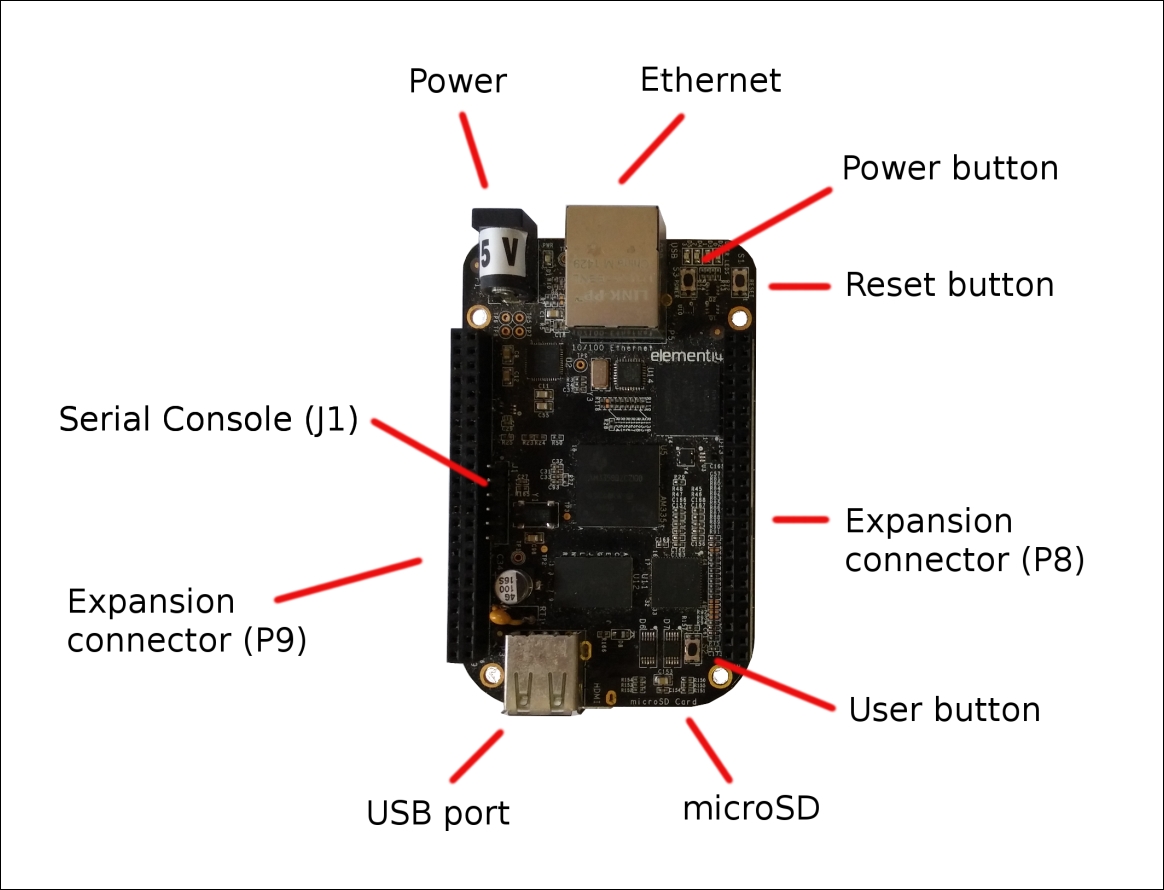
From the preceding image, we can see that the BeagleBone Black doesn't look like a PC, but it can act as a PC! The BeagleBone Black is a fully functional single-board computer and can be readily used as a PC if required by connecting a monitor to the HDMI port and attaching a USB keyboard and mouse through a USB hub. However, it is more suited to embedded applications, where it can act as more than a PC due its expansion connectors, and we can stack up to four expansion boards (named capes) that are useful for several purposes.
In this book, we'll see how we can manage (and reinstall) a complete Debian distribution that allows us to have a wide set of ready-to-run software packages, as a normal PC may have (in fact, the Debian ARM version is equivalent to the Debian x86 version). Then, we'll see how we can use the expansion connectors to connect to the board. Several peripherals are used to monitor/control the external environment.
In the following image, as done earlier, there is a picture of the SAMA5D3 Xplained, with a credit card, where we can easily notice that compared to the BeagleBone Black, this board is larger. This is due the fact that we have more connectors and ports mounted on the board. In particular, the expansion connector in the center of the board is Arduino R3 compatible, so we can use its extension boards on it:
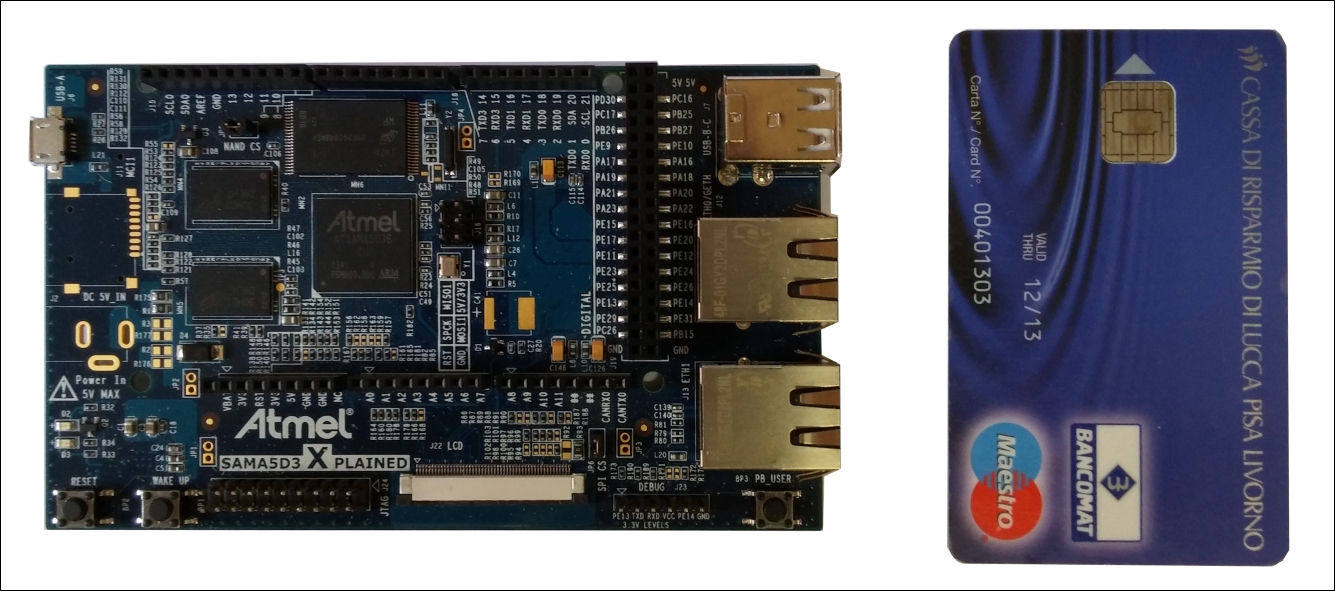
Here are some interesting URLs where you can read about SAMA5D3 Xplained:
Note that there are several versions of the SAMA5D3 Xplained board depending on the CPU version, so we can have SATSAMA5D31, SATSAMA5D33, SATSAMA5D34, SATSAMA5D35, and ATSAMA5D36. Each CPU has the same core, but a different peripheral set.
In this book, we will use ATSAMA5D36, and the main hardware key features of this version are reported in the following table:
|
Part |
Specification |
|
Main processor |
ARM processor: Cortex-A5 @ 536Mhz |
|
Graphic processor |
LCD controller with graphics accelerator |
|
SDRAM memory |
256MB DDR2 |
|
On-board flash |
256MB, NAND flash |
|
USB 2.0 ports |
1 device
2 host
|
|
Serial port |
UART0 via 6 pin 3.3 V TTL connector |
|
Ethernet |
1 port 10/100/1000 via RJ45 connector
1 port 10/100 via RJ45 connector
|
|
SD/MMC |
1 slot SD/MMCPlus 8-bit
1 slot microSD 4-bit (not soldered)
|
|
Video/audio out |
Digital interface |
|
Buttons |
1 for reset
1 for wake up
1 user controllable
|
|
LED indicators |
1 for power
2 on each Ethernet port
1 user controllable
|
|
On-board Wi-Fi/bluetooth |
Optional WiFi via SDIO expansion |
|
SATA |
None |
|
Expansion
Connectors
|
GPIOs 3.3V
SPI, I2C0-1, CAN0-1, VBAT
12 ADC (3.3V max)
2 timers
6 serial ports
2 PWMs
|
|
J-TAG connector |
20 pins J-TAG (populated) |
The following image shows a top view of the SAMA5D3 Xplained, where we can see some interesting things:
The connector J23 can be used to access the serial console.
The USB micro port can be used obviously as a USB device interface, but it is used also as a power supply port and as a SAM-BA USB device and USB CDC connection.
The two Ethernet connectors.
The LCD connector.
The JTAG connector.
The two USB host ports.
The expansion connector (note that these connectors are Arduino R3 compatible).
The reset button can be used to reset the board. The wake up button can be used to turn on/off the board.
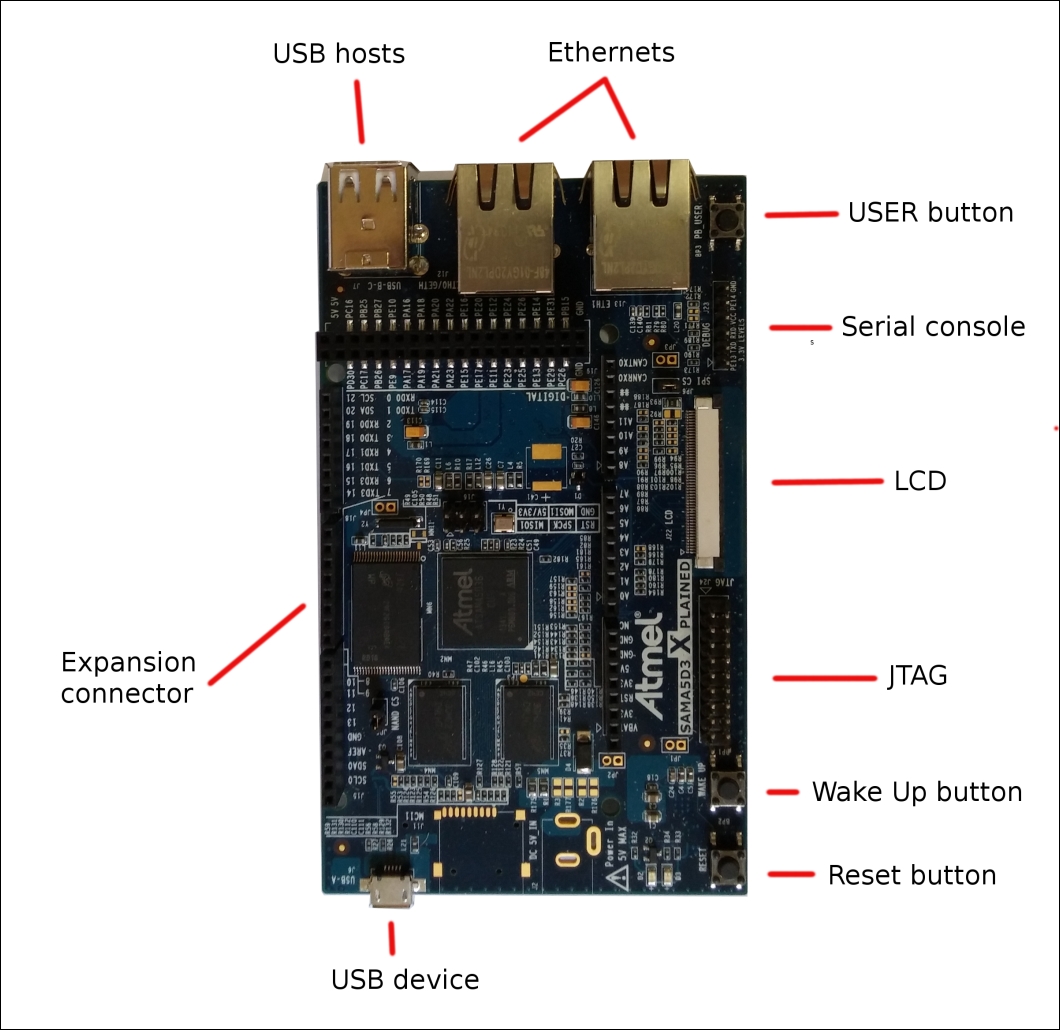
This board can also act as a PC, even if it is designed for typical industrial tasks. It can resist in very hostile environment. It has low power consumption and a lot of useful peripherals for professional applications. In contrast to the BeagleBone Black, it has no HDMI connector for external monitor, but it has a dedicated connector for an LCD with touch screen.
Even for this board, we'll install a complete Debian distribution and see how we can use the expansion connectors to connect to the board.
In the following image, there is a picture of the Wandboard, with the same credit card shown earlier:
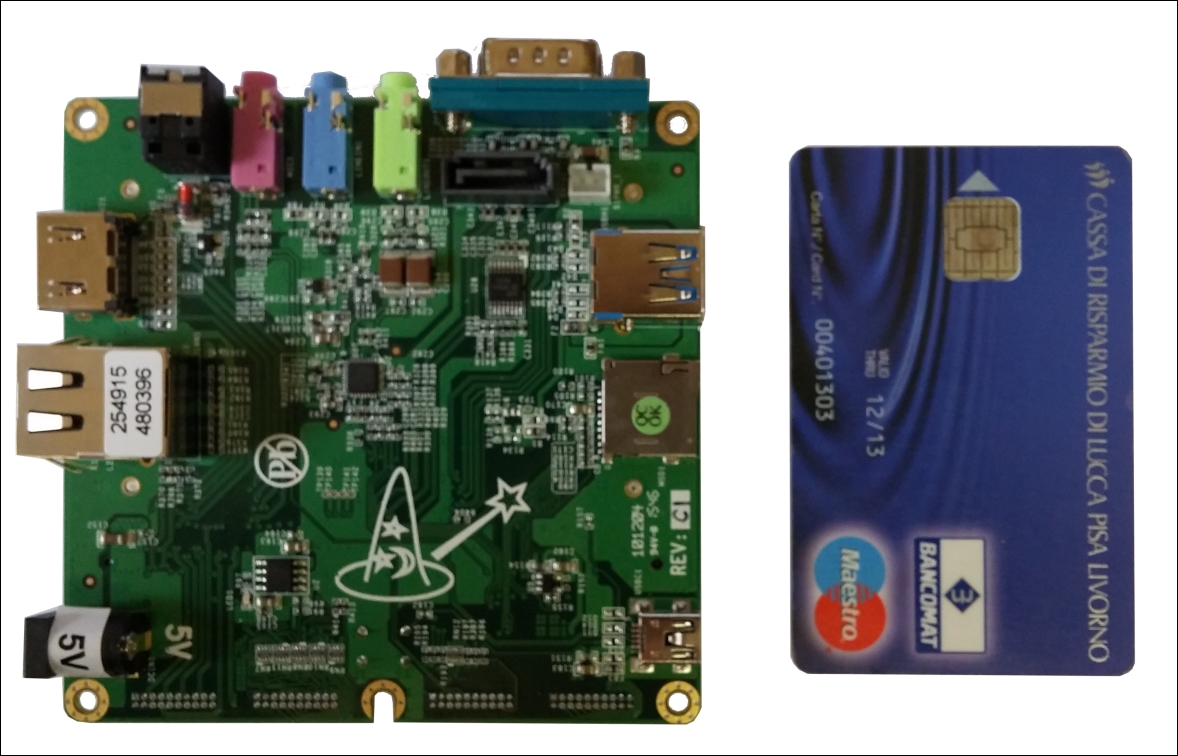
The board seems quite small, but it's actually composed of two parts: the core module is on top of the interface (or carrier) module (see the following image):
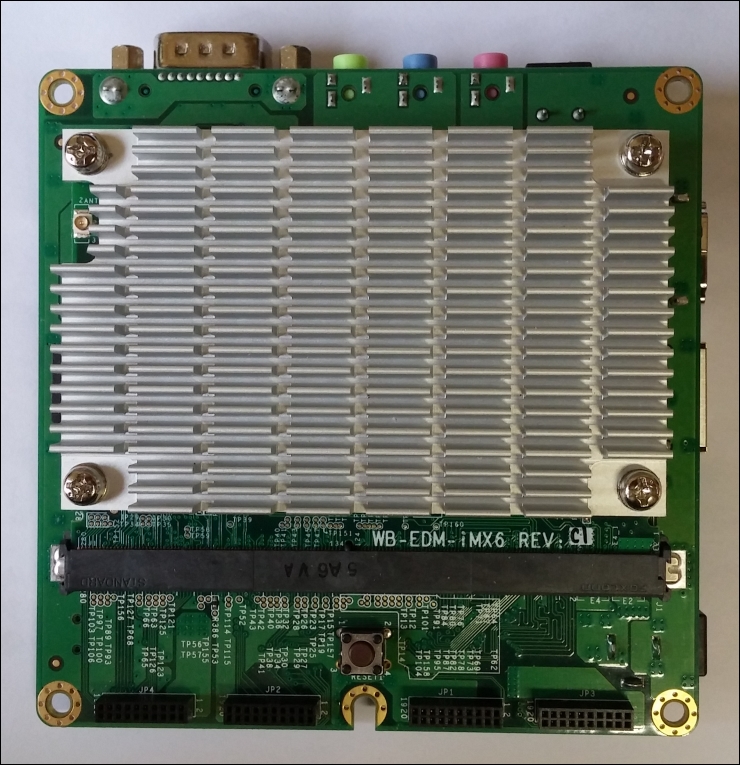
Here are some interesting URLs where you can gain some useful information regarding your Wandboard:
Note that there are several versions of the Wandboard board depending on the CPU version, so we can have the Wandboard Solo, Wandboard Dual, and Wandboard Quad. Each version has a different CPU with the same core but a different peripheral set and core numbers. In fact, the Wandboard is available as a single-, dual-, and quad-core CPU!
In this book, we will use the Wandboard Quad (revision C1), and the main hardware key features of this version are reported in the following table:
|
Part |
Specification |
|
Main processor |
ARM processor: Quad Cortex-A9 @ 1Ghz |
|
Graphic processor |
Vivante GC 2000 + Vivante GC 355 + Vivante GC 320 |
|
SDRAM memory |
2GB DDR3 |
|
On-board flash |
None |
|
USB 2.0 ports |
1 OTG
2 host
|
|
Serial port |
UART0 via standard RS232 pin9 connector |
|
Ethernet |
1 port 10/100/1000 via RJ45 connector |
|
SD/MMC |
2 slot SD/MMCPlus 8-bit |
|
Video/audio out |
HDMI
Analog audio plus optical S/P DIF
Digital camera connector
|
|
Buttons |
1 for reset |
|
LED indicators |
1 for power
2 on Ethernet port
|
|
On-board Wi-Fi/bluetooth |
802.11n/4.0 |
|
SATA |
1 connector |
|
Expansion
connectors
|
GPIOs 3.3V
SPI, I2C0-1, CAN0-1, VBAT
12 ADC (3.3V max)
2 timers
6 serial ports
2 PWMs
|
|
J-TAG connector |
8 pins J-TAG (not populated) |
The following two images show the bottom and top views of the Wandboard, where we can see some interesting things. Here are the features of the bottom side of the board:
The RS-232 9-pins connector COM1 can be used to access the serial console
The USB mini port used as USB OTG connector
The USB host port
The secondary microSD connector
The power connector
The Ethernet connector
The audio ports
The SATA connector
The HDMI connector
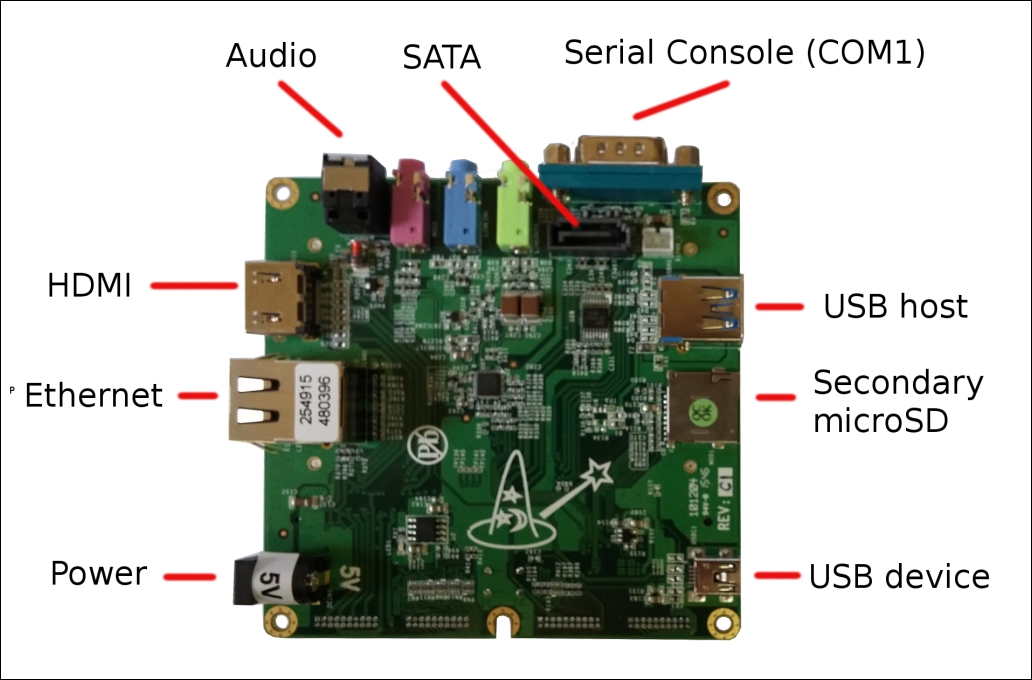
On the top side (we split the core module on the left and the interface board on the right) we have:
The camera interface connector
The primary microSD
The Wi-Fi chip
The four expansion connectors
The reset button can be used to reset the board
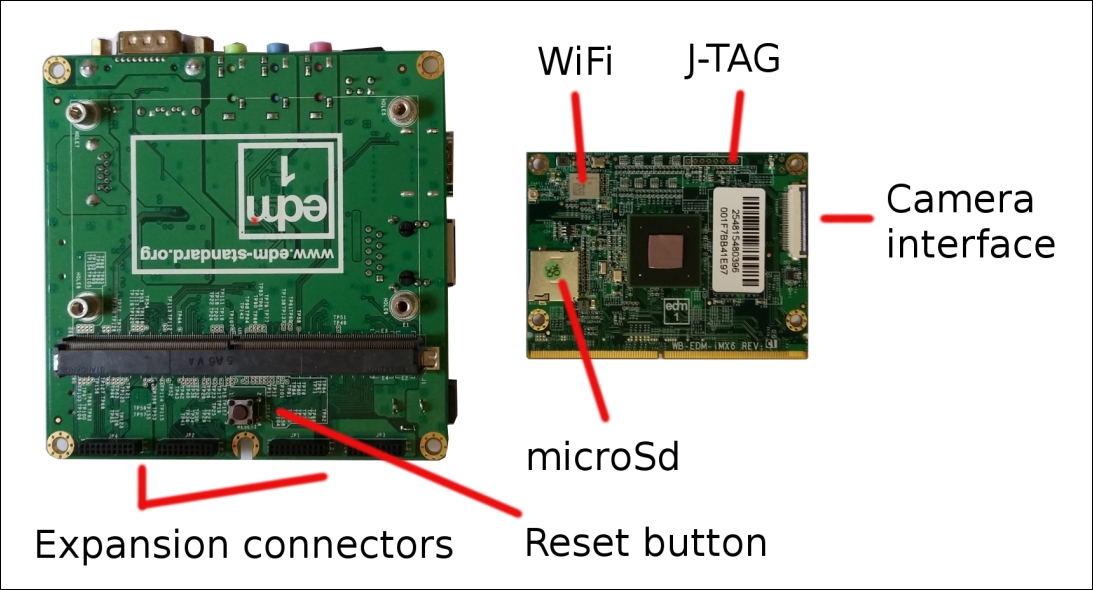
This board too can act as a PC, and that's why we will install a complete Debian distribution on it too. This board, as in the case of the BeagleBone Black, has a HDMI connector for external monitor.
The target of this book is to explain how to get access to the several peripherals present on our boards and how to quickly write programs to manage their data. In order to do it, we need a good developing system. That's why, in this section, we will install a Debian OS on each board.
One of the main advantages of GNU/Linux-based boards is the fact that we can have the same developing environment regardless of the board we decide to use. In order to practically demonstrate this fact, we will install exactly the same OS on each board (even if a preloaded OS may be already present on some boards). To do this, we just need an SD (or microSD) card to store our developing OS and then follow the instructions in the upcoming sections.
However, before putting our hands on the embedded boards, we need to set up our host machine.
As every good embedded developer knows, a host machine is absolutely necessary. Even if the embedded devices are getting more powerful nowadays, there are some resource-consuming tasks where a host machine can help.
The host machine we decide to use could be a normal PC or a virtualized one. The important thing is that it runs a GNU/Linux-based OS! In this book, we will use an Ubuntu 15.10 based system (since this is currently my laptop's configuration), you can decide to use the same (maybe in a virtual machine) or just to use an Ubuntu Long Term Support (LTS) release, such as 16.04 for instance, without any problem or major changes. However, we can also try to replicate some settings and installation commands that we will use during the course of the book into another Linux distribution with little effort.
If we did a clean installation or we have never used our machine as a developing one, then we have to install some useful developing tools before continuing. As the first step, we will install the aptitude tool, which is quite similar to the most famous apt-get command, but it's smarter (note that this is not required since we may still continue using apt-get without any problems). Here is the installing command:
$ sudo apt-get install aptitude
Then, we can install other useful basic tools using the aptitude command as shown here:
$ sudo aptitude install openssh-server tree git device-tree-compiler lzma lzop libncurses5-dev:amd64 minicom
After all packages have been installed, we can go further and install the cross-compiler with the relative toolchain.
Every host machine needs a proper cross-compiler for the target board we wish to work on, so we have to install one. As we can see in the upcoming chapters, we mainly need a cross-compiler to build the bootloader and the kernel, since we can directly compile user-space applications on the target itself due the fact we're using Debian. However, we can use it for several other tasks, for instance, to compile specific drivers and/or to compile user-space applications even if, in this last case, we need to be careful to keep the cross toolchain in step with the target (having compatible library versions, header files, and so on). Otherwise, it would case subtle problems from time to time.
Tip
Note that if we use an embedded distribution such as Yocto or OpenWrt (Chapter 5, Setting Up an Embedded OS), we must use the cross-compiler to compile user-space applications too, since we have no native compiler to execute on the boards.
There are several solutions to install a cross-compiler, starting from installing the one supplied by the used distribution to using a pre-built one. Ubuntu has its own cross-compiler, as shown here, using the following command:
$ apt-cache search gcc-[0-9.]*-arm gcc-5-arm-linux-gnueabihf - GNU C compiler gcc-5-arm-linux-gnueabihf-base - GCC, the GNU Compiler Collection (bas e package) gcc-4.7-arm-linux-gnueabi - GNU C compiler gcc-4.7-arm-linux-gnueabi-base - GCC, the GNU Compiler Collection (bas e package) gcc-4.7-arm-linux-gnueabihf - GNU C compiler gcc-4.7-arm-linux-gnueabihf-base - GCC, the GNU Compiler Collection (b ase package) gcc-4.8-arm-linux-gnueabihf - GNU C compiler gcc-4.8-arm-linux-gnueabihf-base - GCC, the GNU Compiler Collection (b ase package) gcc-4.9-arm-linux-gnueabi - GNU C compiler gcc-4.9-arm-linux-gnueabi-base - GCC, the GNU Compiler Collection (bas e package) gcc-4.9-arm-linux-gnueabihf - GNU C compiler gcc-4.9-arm-linux-gnueabihf-base - GCC, the GNU Compiler Collection (b ase package) gcc-5-arm-linux-gnueabi - GNU C compiler gcc-5-arm-linux-gnueabi-base - GCC, the GNU Compiler Collection (base package)
Note
Downloading the example code
Detailed steps to download the code bundle are mentioned in the Preface of this book.
The code bundle for the book is also hosted on GitHub at: https://github.com/PacktPublishing/GNU-Linux-Rapid-Embedded-Programming/.
We also have other code bundles from our rich catalog of books and videos available at: https://github.com/PacktPublishing/. Check them out!
However in order to have a distro-independent installation, we decide to use a pre-built one. Looking at the available ones, we chose the toolchain from the Linaro project ( http://www.linaro.org/ ), which is a de-facto standard. So, let's see how to install it.
First of all, we must download the archive using the following command:
$ wget -c https://releases.linaro.org/components/toolchain/binaries/5.
3-2016.02/arm-linux-gnueabihf/gcc-linaro-5.3-2016.02-x86_64_arm-linux-
gnueabihf.tar.xz
After the download, we need to extract the code using the following command:
$ tar xf gcc-linaro-5.3-2016.02-x86_64_arm-linux-gnueabihf.tar.xz
Note
You can put your new toolchain whenever you wish inside the host's filesystem. We put it in the /opt/linaro directory.
Then, we have to set up our environment in order to be able to execute the cross-compiler and other components:
$ export PATH=/opt/linaro/gcc-linaro-5.3-2016.02-x86_64_arm-linux-gnue abihf/bin/:$PATH
Now, we should get the following lines of code:
$ arm-linux-gnueabihf-gcc --version arm-linux-gnueabihf-gcc (Linaro GCC 5.3-2016.02) 5.3.1 20160113 Copyright (C) 2015 Free Software Foundation, Inc. This is free software; see the source for copying conditions. There is NO warranty; not even for MERCHANTABILITY or FITNESS FOR A PARTICULAR PURPOSE.
Note
Each time we log in to our host machine, we have to execute the preceding export command. To avoid it, we can use the following two lines to the .bashrc file (if we use the Bash shell):
# Setup the cross-compiler export PATH=/opt/linaro/gcc-linaro-5.3-2016.02-x86_ 64_arm-linux-gnueabihf/bin/:$PATHOK. Now, we're ready to set up our developer kits!
Let's start by putting our hands on the first developer kit: the BeagleBone Black. As we can see, it comes with a pre-loaded Debian system on the on-board eMMC. However, since we'd like to have the same OS on all developer kits, let's see how to install a fresh OS on a new microSD and then boot from it.
As already stated (and as any real programmer of embedded devices knows), the serial console is a must-have during the low-level development stages! So, let's see how we can get access to it on our BeagleBone Black.
As shown in the following image, the connector J1 is exposed to the serial console pins. So, using a proper adapter, we can connect it to our host PC. However, since the pins have electrical signals at the TTL level, we need an adapter device to do the job, and we have several possibilities.
The first one is a standard RS232-to-TTL converter shown in the following image:
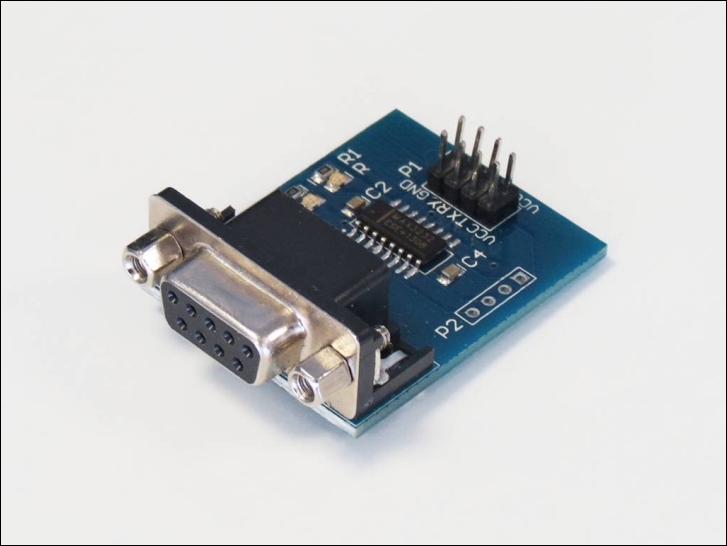
Note
The RS232-to-TTL converter can be purchased at: http://www.cosino.io/product/rs-232-serial-adapter or by surfing the Internet.
In this case, we need a PC equipped with a standard RS232 port. Nowadays, it is not easy having one, but we can easily find a RS232-to-USB adapter to solve the problem, or as a second possibility, we can use a standard USB-to-TTL cable shown here:
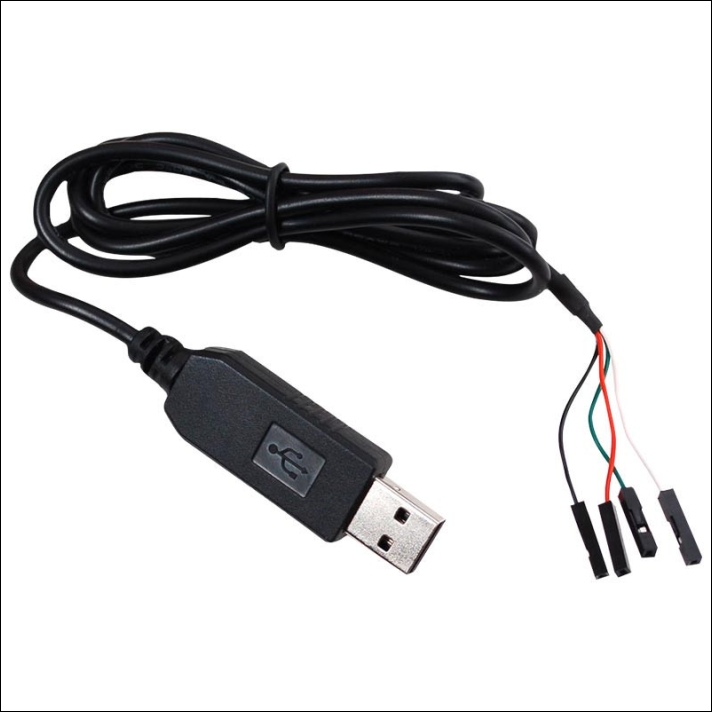
The solution allows us to use a more common USB port to do the job.
However, a last solution exists, and it consists of still using an USB-to-TTL converter. However, in contrast with the solution mentioned earlier, this time, we have a micro USB port used in every smartphone. The converter is shown in the following image:
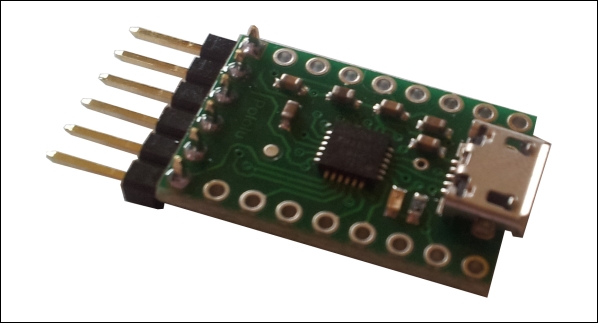
Note
The devices can be purchased at: http://www.cosino.io/product/usb-to-serial-converter or by surfing the Internet.
The datasheet of this device is available at: https://www.silabs.com/Support%20Documents/TechnicalDocs/cp2104.pdf.
Whichever solution we decide to use, we have to connect the J1 connector with the selected adapter in order to correctly capture the electrical signal. In particular, the relevant pins are reported in the following table. You have to connect the GND (Ground) signal with the adapter's GND pin and then swap TxD (Transmitter) and RxD (Receiver) to correctly establish the serial connection.
|
Connector J1 |
Function |
|
Pin 1 |
GND |
|
Pin 4 |
TxD |
|
Pin 5 |
RxD |
Here is the my setup:
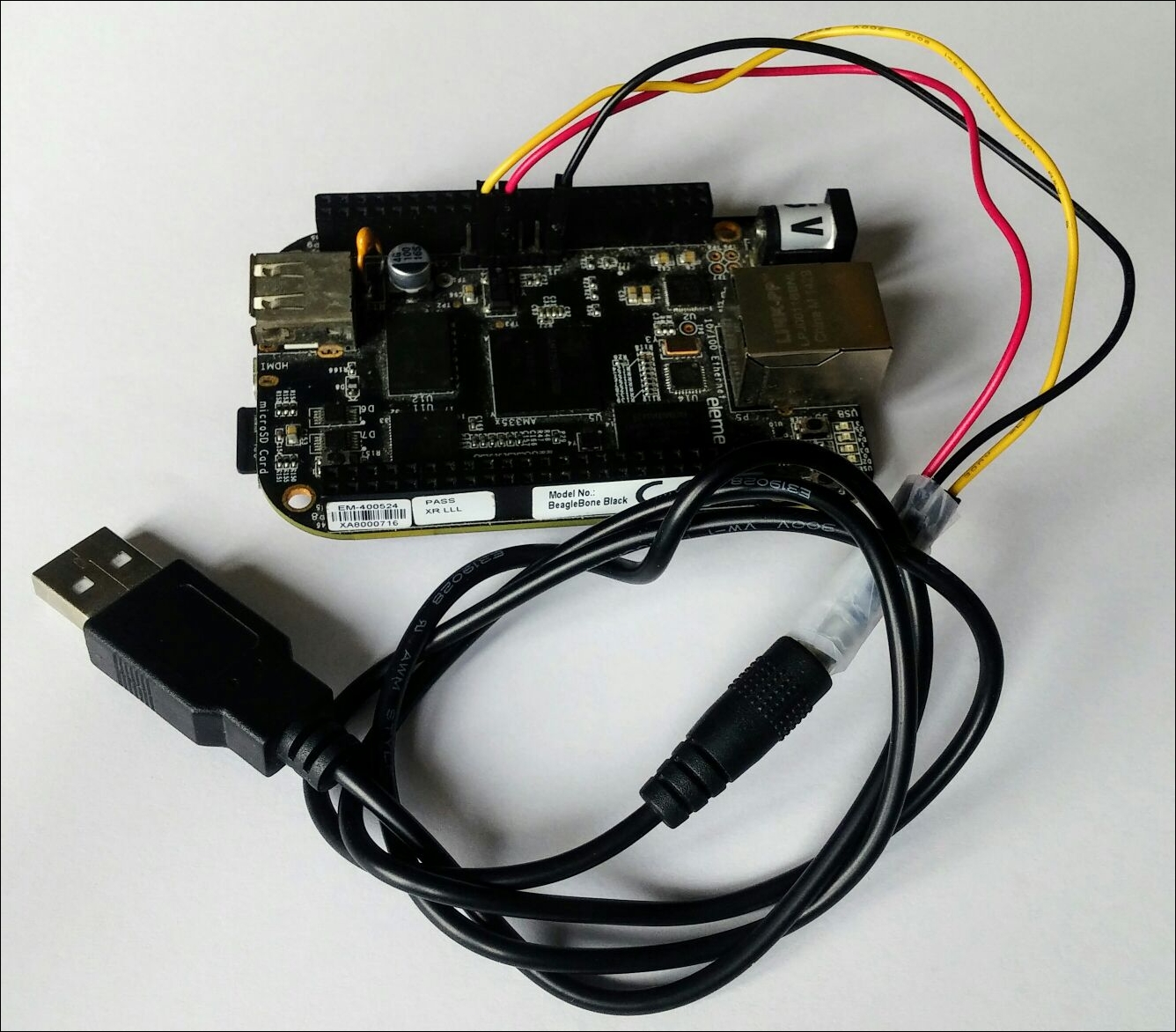
If all connections are OK, we can execute any serial terminal emulator to see the data from the serial console. We will use the minicom tool, and the command to use it is shown here:
$ minicom -o -D /dev/ttyUSB0
You must now verify that the serial port to be used is /dev/ttyUSB0,
and that its setup is 115200,8N1 without hardware and software flow control (in minicom, these settings can be checked using the
CTRL+A-O
key sequence and then selecting the serial port setup menu entry).
Note
To correctly get access to the serial console, we may need proper privileges. In fact, we may try to execute the preceding minicom command, and we don't get an output! This is because the minicom command silently exits if we don't have enough privileges to get access to the port.
We can verify our access to privileges by simply using another command on it as shown here:
$ cat /dev/ttyUSB0
cat: /dev/ttyUSB0: Permission denied
In this case, the cat command perfectly tells us what's wrong. In this case, we can fix this issue using the sudo command or, even better, by properly adding our system's user to the right group as shown here:
$ ls -l /dev/ttyUSB0 crw-rw---- 1 root dialout 188, 0 Jan 12 23:06 /dev /ttyUSB0 $ sudo adduser $LOGNAME dialout
oinThen, log out and log in again, and we can access the serial devices without any problem.
The BeagleBone Black should come with a pre-loaded system, so we should see the booting sequence in the minicom window as soon as we power up the system.
Now, we only need the software to start working with our BeagleBone Black board.
First of all, we have to download the sources and select a proper release to compile. To clone the U-Boot's repository, we can use the following command:
$ git clone https://github.com/u-boot/u-boot
However, instead of using the preceding command, let me suggest that you clone U-Boot's repository into a dedicated directory in the bare form (we use a directory named common) and then clone the BeagleBone Black's files into another subdirectory by referencing the local bare repository to the dedicated one (we use the directory BBB).
To download the bare repository, the commands are as follows:
$ cd common $ git clone --bare https://github.com/u-boot/u-boot
Then, the new commands to get the BeagleBone Black's sources are as follows:
$ cd BBB $ git clone --reference ~/Projects/common/u-boot.git https://github.com/u-boot/u-boot
In this manner, we can save a lot of disk space since we will use the same sources for all our developer kits.
Now, let's go into the newly created directory and check out a proper U-Boot release:
$ cd u-boot $ git checkout v2016.03 -b v2016.03
Now, we need some patches to properly support the BeagleBone Black, and we can get and install them using the following commands:
$ wget -c https://rcn-ee.com/repos/git/u-boot-patches/v2016.03/0001-am 335x_evm-uEnv.txt-bootz-n-fixes.patch $ patch -p1 < 0001-am335x_evm-uEnv.txt-bootz-n-fixes.patch
Now, we're ready to compile. Let's do it with the following commands:
$ make ARCH=arm CROSS_COMPILE=arm-linux-gnueabihf- am335x_evm_defconfig $ make ARCH=arm CROSS_COMPILE=arm-linux-gnueabihf-
Now, it's time to install the bootloader into the microSD, and to do this, we have plug a new microSD into our host PC. Then, we have to erase the current partition table and install a new one.
However, we first have to discover the microSD associated device. There exist several ways to do it. We usually use the dmesg command after we have plugged in the microSD into my host machine so that we see the following kernel messages:
Attached scsi generic sg3 type 0 [sdd] 7774208 512-byte logical blocks: (3.98 GB/3.71 GiB) [sdd] Write Protect is off [sdd] Mode Sense: 0b 00 00 08 [sdd] No Caching mode page found [sdd] Assuming drive cache: write through sdd: sdd1 [sdd] Attached SCSI removable disk
In this way, we know that on our system, the microSD is associated with the device /dev/sdd.
Note
Note that our configuration may vary. In fact, you may discover that the right device to use is /dev/sdb, /dev/sdc or /dev/sde or even a device named /dev/mmcblk0! This last case means that the host PC is using an MMC device instead of a USB adapter to manage its SD or microSD slot. In this special situation, the kernel messages look like this:
mmc0: cannot verify signal voltage switch
mmc0: new ultra high speed SDR50 SDHC card at address
0007
mmcblk0: mmc0:0007 SD4GB 3.70 GiB
mmcblk0: p1
However, we can also use the lsblk command that nicely lists all the currently attached block devices into the system as show here:
$ lsblk NAME MAJ:MIN RM SIZE RO TYPE MOUNTPOINT sda 8:0 0 465.8G 0 disk +-sda1 8:1 0 21.5G 0 part +-sda2 8:2 0 116.4G 0 part +-sda3 8:3 0 1K 0 part \-sda5 8:5 0 327.9G 0 part /opt sdb 8:16 0 931.5G 0 disk \-sdb1 8:17 0 931.5G 0 part /home sdc 8:32 0 223.6G 0 disk \-sdc1 8:33 0 223.6G 0 part / sdd 8:48 1 3.7G 0 disk \-sdd1 8:49 1 3.7G 0 part
Now, we can clear the current partition table using the following command:
$ sudo dd if=/dev/zero of=/dev/sdX bs=1M count=10
Note
This is a very important step!
The reader should not forget to replace device /dev/sdX with the device associated with the microSD plugged into their system and follow the next steps carefully or they may damage the host system!
Then, we can install the newly compiled bootloaders:
$ sudo dd if=MLO of=/dev/sdX count=1 seek=1 bs=128k $ sudo dd if=u-boot.img of=/dev/sdX count=2 seek=1 bs=384k
Now, we can prepare the needed partition for the root filesystem, which will be installed in the upcoming sections. Here are the commands:
$ echo '1M,,L,*' | sudo sfdisk /dev/sdX $ sudo mkfs.ext4 -L rootfs /dev/sdX1
Note
Since in mkfs.ext4 version 1.43, the options metadata_csum and 64bit are enabled by default. However, we need to make sure that they are disabled; otherwise, U-Boot cannot boot from our ext4 partitions. If this is our case, we need to replace the preceding command with the following one:
$ sudo mkfs.ext4 -L rootfs
-O ^metadata_csum,^64bit /dev/sdX1
In order to get the current version of mkfs.ext4, we can use the command with the -V option argument.
Then, mount the newly created partition and copy the bootloaders in it (these will be used soon). Here are the commands:
$ sudo mkdir /media/rootfs $ sudo mount /dev/sdX1 /media/rootfs/ $ sudo mkdir -p /media/rootfs/opt/backup/uboot/ $ sudo cp MLO /media/rootfs/opt/backup/uboot/ $ sudo cp u-boot.img /media/rootfs/opt/backup/uboot/
Now, we have just to add U-Boot's environment commands to properly load the kernel. We have to put all commands into a file called uEnv.txt in rootfs as follows:
$ sudo mkdir /media/rootfs/boot/ $ sudo cp uEnv.txt /media/rootfs/boot/
The content of the uEnv.txt file is reported here:
loadaddr=0x82000000
fdtaddr=0x88000000
rdaddr=0x88080000
initrd_high=0xffffffff
fdt_high=0xffffffff
mmcroot=/dev/mmcblk0p1
loadximage=load mmc 0:1 ${loadaddr} /boot/vmlinuz-${uname_r}
loadxfdt=load mmc 0:1 ${fdtaddr} /boot/dtbs/${uname_r}/${fdtfile}
loadxrd=load mmc 0:1 ${rdaddr} /boot/initrd.img-${uname_r}; setenv rds
ize ${filesize}
loaduEnvtxt=load mmc 0:1 ${loadaddr} /boot/uEnv.txt ; env import -t ${
loadaddr} ${filesize};
loadall=run loaduEnvtxt; run loadximage; run loadxfdt;
mmcargs=setenv bootargs console=tty0 console=${console} ${optargs} ${c
ape_disable} ${cape_enable} root=${mmcroot} rootfstype=${mmcrootfstype
} ${cmdline}
uenvcmd=run loadall; run mmcargs; bootz ${loadaddr} - ${fdtaddr};
Note
The preceding text can be found in the chapter_01/BBB-uEnv.txt file in the book's example code repository.
Now, it's time to compile the kernel.
The kernel sources can be downloaded from the several repositories, and we decided to use the ones from Robert C. Nelson archives instead of the standard Debian repositories because these repositories are really well done, easy to use, and well supported in terms of custom kernel sources for our embedded kits!
The command is here:
$ git clone https://github.com/RobertCNelson/bb-kernel
Then, we have to enter into the newly created directory and choose which version of the kernel we wish to use. There are several choices, and I decided to use the kernel version 4.4 (no specific reasons for that, it's just the release in the middle and you can choose whatever better fits your needs). So, we used the commands here:
$ cd bb-kernel $ git checkout origin/am33x-v4.4 -b am33x-v4.4
Now, before continuing, we can do something similar to what we did for U-Boot and then pre-download a Linux bare repository from the linux-stable tree into the common directory with the following command:
$ cd common $ git clone --bare https://git.kernel.org/pub/scm/linux/kernel/git/stable/ linux-stable.git
Then, we have to do a little trick to transform the just downloaded data in a form suitable for the build_kernel.sh script we've to use here:
$ mkdir linux-stable $ mv linux-stable.git/ linux-stable/.git $ cd linux-stable $ git config --local --bool core.bare false
In this manner, we converted a bare repository into a normal one, but without checking out any file and saving a lot of disk space!
Now, by properly setting the LINUX_GIT variable into the system.sh file, we can reference the just downloaded repository. The system.sh file can be easily obtained from system.sh.sample as follows:
$ cp system.sh.sample system.sh
Then, we need to properly set the LINUX_GIT and the CC variables (to specify the cross-compiler to be used) as reported in the following patch:
--- system.sh.sample 2016-04-15 18:04:18.178681406 +0200 +++ system.sh 2016-04-18 17:40:11.229958465 +0200 @@ -16,12 +16,14 @@ #CC=<enter full path>/bin/arm-none-eabi- #CC=<enter full path>/bin/arm-linux-gnueabi- #CC=<enter full path>/bin/arm-linux-gnueabihf- +CC=arm-linux-gnueabihf- ###OPTIONAL: ###OPTIONAL: LINUX_GIT: specify location of locally cloned git tree. # #LINUX_GIT=/home/user/linux-stable/ +LINUX_GIT=~/Projects/common/linux-stable ###OPTIONAL: MMC: (REQUIRED FOR RUNNING: tools/install_kernel.sh) #Note: This operates on raw disks, NOT PARTITIONS..
Now, we have to set up our identity into the new git repository with the following commands:
$ git config --global user.name "Rodolfo Giometti" $ git config --global user.email "giometti@hce-engineering.com"
Then, we can start the compilation with the following command:
$ ./build_kernel.sh
Note
This step and the subsequent ones are time consuming and require patience, so you should take a cup of your preferred tea or coffee and just wait.
We should see that the correct cross-compiler is set and also the linux-stable repository is correctly referenced. Here is what I gets on my system:
$ ./build_kernel.sh + Detected build host [Ubuntu 15.10] + host: [x86_64] + git HEAD commit: [72cf1bea12eea59be6632c9e9582f59e7f63ab3d] ----------------------------- scripts/gcc: Using: arm-linux-gnueabihf-gcc (Linaro GCC 5.3-2016.02) 5 .3.1 20160113 Copyright (C) 2015 Free Software Foundation, Inc. This is free software; see the source for copying conditions. There i s NO warranty; not even for MERCHANTABILITY or FITNESS FOR A PARTICULA R PUR POSE. ----------------------------- CROSS_COMPILE=arm-linux-gnueabihf- ----------------------------- scripts/git: Debug: LINUX_GIT is setup as: [/home/giometti/Projects/co mmon/linux-stable]. scripts/git: [url=https://git.kernel.org/pub/scm/linux/kernel/git/stab le/linux-stable.git] From https://git.kernel.org/pub/scm/linux/kernel/git/stable/linux-stab le * branch HEAD -> FETCH_HEAD ----------------------------- Cloning into '/home/giometti/Projects/BBB/bb-kernel/KERNEL'... done. ...
After a while, the classic kernel configuration panel should appear. Just confirm the default settings by selecting the < Exit > menu option and then continue.
When finished, we should see several messages as shown here:
... ----------------------------- 'arch/arm/boot/zImage' -> '/home/giometti/Projects/BBB/bb-kernel/deplo y/4.4.7-bone9.zImage' '.config' -> '/home/giometti/Projects/BBB/bb-kernel/deploy/config-4.4. 7-bone9' -rwxrwxr-x 1 giometti giometti 7,1M apr 15 18:54 /home/giometti/Projec ts/BBB/bb-kernel/deploy/4.4.7-bone9.zImage ----------------------------- Building modules archive... Compressing 4.4.7-bone9-modules.tar.gz... -rw-rw-r-- 1 giometti giometti 58M apr 15 18:55 /home/giometti/Project s/BBB/bb-kernel/deploy/4.4.7-bone9-modules.tar.gz ----------------------------- Building firmware archive... Compressing 4.4.7-bone9-firmware.tar.gz... -rw-rw-r-- 1 giometti giometti 1,2M apr 15 18:55 /home/giometti/Projec ts/BBB/bb-kernel/deploy/4.4.7-bone9-firmware.tar.gz ----------------------------- Building dtbs archive... Compressing 4.4.7-bone9-dtbs.tar.gz... -rw-rw-r-- 1 giometti giometti 328K apr 15 18:55 /home/giometti/Projec ts/BBB/bb-kernel/deploy/4.4.7-bone9-dtbs.tar.gz ----------------------------- Script Complete eewiki.net: [user@localhost:~$ export kernel_version=4.4.7-bone9] -----------------------------
The last line tell us which is the kernel version to be defined into the uEnv.txt file defined earlier when we installed the bootloaders. The command is shown here:
$ sudo sh -c 'echo "uname_r=4.4.7-bone9" >>
/media/rootfs/boot/uEnv.txt'
Now, we should install the kernel, but before doing it, we need the root filesystem, so let's move to the next subsection.
To install the rootfs directory containing our Debian OS, we can use a pre-built image, and again, we can download it into the common directory to save space. The commands are shown here:
$ cd common $ wget wget -c https://rcn-ee.com/rootfs/eewiki/minfs/debian-8.4-minim al-armhf-2016-04-02.tar.xz
Then, we can explore it by using the tar command:
$ tar xf debian-8.4-minimal-armhf-2016-04-02.tar.xz
Note
By the time you read this, new versions could be available or the current one could be missing. Then, we should verify the available versions in the case of errors while downloading the rootfs image used earlier.
When finished, a new directory named debian-8.4-minimal-armhf-2016-04-02 should be available on the current working directory, and to copy it on the microSD, we can use this command:
$ cd debian-8.4-minimal-armhf-2016-04-02/ $ sudo tar xpf armhf-rootfs-debian-jessie.tar -C /media/rootfs/
When finished, we can add the kernel image and its related files compiled earlier by switching back to the kernel repository and then using these commands:
$ cd BBB/bb-kernel $ sudo cp deploy/4.4.7-bone9.zImage /media/rootfs/boot/vmlinuz-4.4.7-bone9 $ sudo mkdir -p /media/rootfs/boot/dtbs/4.4.7-bone9/ $ sudo tar xf deploy/4.4.7-bone9-dtbs.tar.gz -C /media/rootfs/boot/dtbs/4.4.7-bone9/ $ sudo tar xf deploy/4.4.7-bone9-modules.tar.gz -C /media/rootfs/
Now, to finish the job, we must set up the filesystem table using the following command:
$ sudo sh -c "echo '/dev/mmcblk0p1 / auto errors=remount-ro 0 1' >
/media/rootfs/etc/fstab"
Do the networking configuration by executing the following commands:
$ sudo sh -c "echo 'allow-hotplug lo\niface lo inet loopback\n' > /media/rootfs/etc/network/interfaces" $ sudo sh -c "echo 'allow-hotplug eth0\niface eth0 inet dhcp\n' >> /media/rootfs/etc/network/interfaces"
Now, we should be ready to boot our new system! Let's unmount the microSD from the host PC and plug it into the BeagleBone Black and power on the board. The umount command line is shown here:
$ sudo umount /media/rootfs/
If everything works well on the serial console, we should see something like this:
U-Boot SPL 2016.03-dirty (Apr 15 2016 - 13:44:25)
Trying to boot from MMC
bad magic
U-Boot 2016.03-dirty (Apr 15 2016 - 13:44:25 +0200)
Watchdog enabled
I2C: ready
DRAM: 512 MiB
Reset Source: Power-on reset has occurred.
MMC: OMAP SD/MMC: 0, OMAP SD/MMC: 1
Using default environment
Net: <ethaddr> not set. Validating first E-fuse MAC
cpsw, usb_ether
Press SPACE to abort autoboot in 2 seconds
switch to partitions #0, OK
mmc0 is current device
Scanning mmc 0:1...
...
debug: [console=ttyO0,115200n8 root=/dev/mmcblk0p1 ro rootfstype=ext4
rootwait].
debug: [bootz 0x82000000 - 0x88000000] ...
Kernel image @ 0x82000000 [ 0x000000 - 0x710b38 ]
## Flattened Device Tree blob at 88000000
Booting using the fdt blob at 0x88000000
Using Device Tree in place at 88000000, end 88010a19
Starting kernel ...
[ 0.000000] Booting Linux on physical CPU 0x0...
[ 5.466604] random: systemd urandom read with 17 bits of entropy av
ailable
[ 5.484996] systemd[1]: systemd 215 running in system mode. (+PAM +
AUDIT +SE)
[ 5.498711] systemd[1]: Detected architecture 'arm'.
Welcome to Debian GNU/Linux 8 (jessie)!
[ 5.535458] systemd[1]: Set hostname to <arm>.
[ 5.861405] systemd[1]: Cannot add dependency job for unit display-
manager.s.
...
[ OK ] Started LSB: Apache2 web server.
[ 12.903747] random: nonblocking pool is initialized
Debian GNU/Linux 8 arm ttyS0
default username:password is [debian:temppwd]
arm login:
Note
In order to work, we may need to completely power the BeagleBone Black and then re-power it while keeping the user button pressed. Otherwise, the board will still continue booting from the on-board eMMC.
Great! Everything is working now. We can log in by entering the string root as both username and password.
Now, it's the turn of the SAMA5D3 Xplained. Even this board may have a pre-loaded distribution into its flash memory, but it is an embedded distribution that is not suitable for our purposes. So, as we did for the BeagleBone Black, we will install a fresh Debian OS on a microSD card (in reality, the SAMA5D3 Xplained comes with an SD slot, but we can still use a microSD plugged in an SD adapter).
As shown in the previous section, we have the J23 connector where the serial console pins are exposed. So, again, using a proper adapter, we can connect our host PC with it.
The relevant pins are reported in the table, and you, exactly as you did earlier, have to connect the GND signal with the adapter's GND pin and then swap the TxD and RxD to correctly establish the serial connection.
|
Connector J1 |
Function |
|
Pin 6 |
GND |
|
Pin 2 |
TxD |
|
Pin 3 |
RxD |
The next image shows my setup:
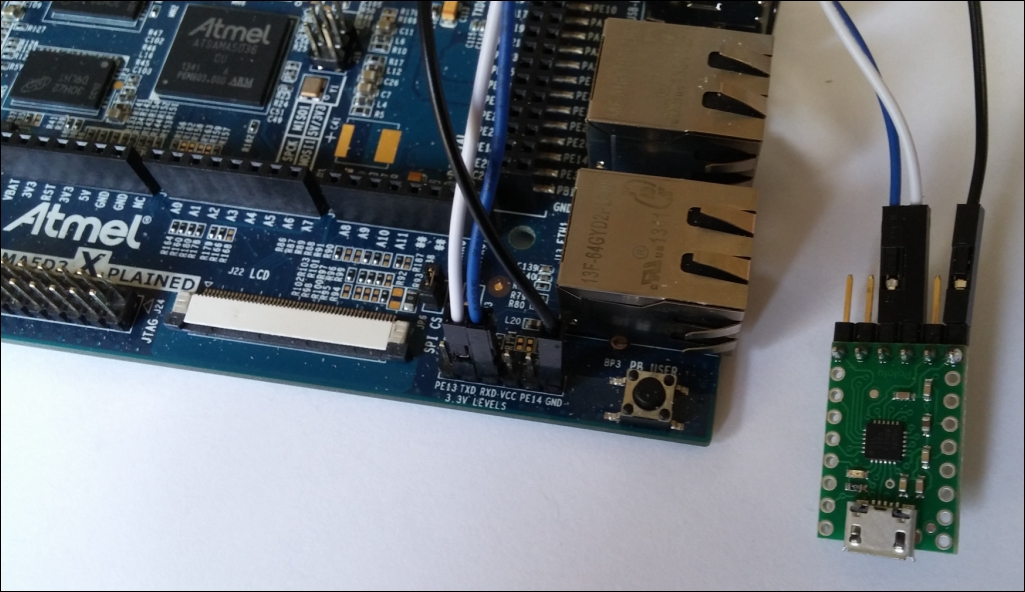
If all connections are OK, we can execute the minicom tool again to see the data from the serial console.
If our SAMA5D3 Xplained comes with a pre-loaded system, we should see the booting sequence in the serial console window. Otherwise, we should simply see the RomBOOT message. In any case, the serial console should be functional.
Note
You should not forget to verify the serial port to be used. You should also see that its setup is 115200,8N1 without hardware and software flow control. See the BeagleBone Black settings earlier.
Now, let's install the software to start working with our SAMA5D3 Xplained board.
To obtain the bootloader's sources, we can use the same trick used for BeagleBone Black's sources. However, this time, the bare repository is already downloaded, so we just need to clone a new one with the following commands (to work with this board, we created the A5D3 directory):
$ cd A5D3 $ git clone --reference ~/Projects/common/u-boot.git https://github.com/u-boot/u-boot
Now, let's go into the newly created directory and check out a proper U-Boot release to use. Here are the commands used:
$ cd u-boot $ git checkout v2016.03 -b v2016.03
Now, just as before, we need some patches to properly support the SAMA5D3 Xplained. We can get them using the following commands:
$ wget -c https://rcn-ee.com/repos/git/u-boot-patches/v2016.03/0001-sa ma5d3_xplained-uEnv.txt-bootz-n-fixes.patch $ patch -p1 < 0001-sama5d3_xplained-uEnv.txt-bootz-n-fixes.patch
Now, we're ready to compile:
$ make ARCH=arm CROSS_COMPILE=arm-linux-gnueabihf- sama5d3_xplained_mmc_defconfig $ make ARCH=arm CROSS_COMPILE=arm-linux-gnueabihf-
Now, let's install the bootloader into the microSD.
Note
As already done earlier, we have to discover the device associated with the microSD (see the the BeagleBone Black subsection).
We can clear the current partition table using the following command:
$ sudo dd if=/dev/zero of=/dev/sdX bs=1M count=50
Note
You should not forget to replace device /dev/sdX with the device associated with the microSD plugged into your system and follow the next steps carefully. Otherwise, it may damage the host system!
Now, we can prepare the needed partitions for the root filesystem, which will be installed in the upcoming sections. Here are the commands:
$ echo -e '1M,48M,0xE,*\n,,,-' | sudo sfdisk /dev/sdX $ sudo mkfs.vfat -F 16 -n BOOT /dev/sdX1 $ sudo mkfs.ext4 -L rootfs /dev/sdX2
Note
As already stated for the BeagleBone Black, we must notice that since the mkfs.ext4 version 1.43, the metadata_csum and 64bit options are enabled by default. However, we need to make sure that they are disabled. Otherwise, U-Boot cannot boot from our ext4 partitions. If this is our case, we need to replace the preceding command with the following one:
$ sudo mkfs.ext4 -L rootfs
-O ^metadata_csum,^64bit /dev/sdX2
Now, we can mount the newly created boot and rootfs partitions in order to be ready to copy the bootloaders and the distro's file into them. Here are the commands:
$ sudo mkdir /media/boot $ sudo mkdir /media/rootfs $ sudo mount /dev/sdX1 /media/boot $ sudo mount /dev/sdX2 /media/rootfs
Then, we can install the newly compiled bootloaders:
$ sudo cp boot.bin /media/boot/ $ sudo cp u-boot.img /media/boot/
Now, it's time to compile the kernel.
Again, the kernel sources can be downloaded from Robert C. Nelson archives. The command is shown here:
$ git clone https://github.com/RobertCNelson/armv7_devel
Then, we have to enter into the newly created directory and choose which version of the kernel we wish to use. Of course, we choose the same kernel release as we did earlier, and here are the commands:
$ cd armv7_devel/ $ git checkout origin/v4.4.x-sama5-armv7 -b v4.4.x-sama5-armv7
Now, we can redo the previous settings into the system.sh file, and then, we can start the compilation using the following command:
$ ./build_kernel.sh
Note
This step and the subsequent ones are time consuming and require patience, so you should take a cup of your preferred tea or coffee and just wait.
We should see that the correct cross-compiler is set and also see that the linux-stable repository is correctly referenced. Here is what I get on my system:
$ ./build_kernel.sh + Detected build host [Ubuntu 15.10] + host: [x86_64] + git HEAD commit: [cc996bf444c2fb5f3859c431fbc3b29fe9ba6877] ----------------------------- scripts/gcc: Using: arm-linux-gnueabihf-gcc (Linaro GCC 5.3-2016.02) 5 .3.1 20160113 Copyright (C) 2015 Free Software Foundation, Inc. This is free software; see the source for copying conditions. There i s NO warranty; not even for MERCHANTABILITY or FITNESS FOR A PARTICULA R PUR POSE. ----------------------------- CROSS_COMPILE=arm-linux-gnueabihf- ----------------------------- scripts/git: Debug: LINUX_GIT is setup as: [/home/giometti/Projects/co mmon/linux-stable]. scripts/git: [url=https://git.kernel.org/pub/scm/linux/kernel/git/stab le/linux-stable.git] From https://git.kernel.org/pub/scm/linux/kernel/git/stable/linux-stab le * branch HEAD -> FETCH_HEAD ----------------------------- Cloning into '/home/giometti/Projects/A5D3/armv7_devel/KERNEL'... done. ...
After a while, the classic kernel configuration panel should appear, but this time, we should change the default configuration. In particular, we wish to change the USB Gadget settings as shown in the following screenshot:
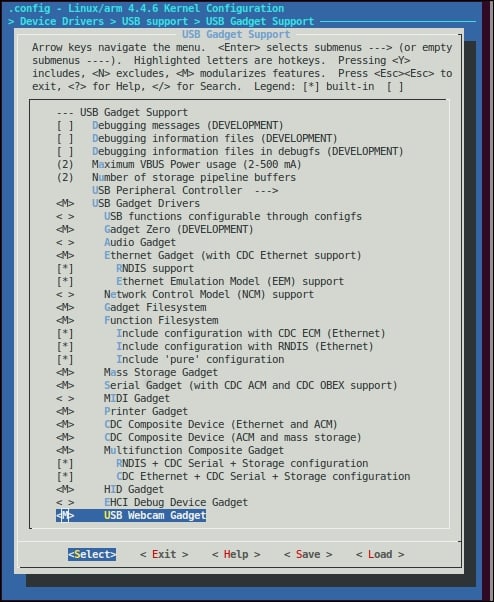
Then, save the configuration and continue. When finished, we should see several messages as shown here:
... ----------------------------- 'arch/arm/boot/zImage' -> '/home/giometti/Projects/A5D3/armv7_devel/de ploy/4.4.6-sama5-armv7-r5.zImage' '.config' -> '/home/giometti/Projects/A5D3/armv7_devel/deploy/config-4 .4.6-sama5-armv7-r5' -rwxrwxr-x 1 giometti giometti 3,7M apr 15 20:19 /home/giometti/Projec ts/A5D3/armv7_devel/deploy/4.4.6-sama5-armv7-r5.zImage ----------------------------- Building modules archive... Compressing 4.4.6-sama5-armv7-r5-modules.tar.gz... -rw-rw-r-- 1 giometti giometti 328K apr 15 20:19 /home/giometti/Projec ts/A5D3/armv7_devel/deploy/4.4.6-sama5-armv7-r5-modules.tar.gz ----------------------------- Building firmware archive... Compressing 4.4.6-sama5-armv7-r5-firmware.tar.gz... -rw-rw-r-- 1 giometti giometti 1,2M apr 15 20:19 /home/giometti/Projec ts/A5D3/armv7_devel/deploy/4.4.6-sama5-armv7-r5-firmware.tar.gz ----------------------------- Building dtbs archive... Compressing 4.4.6-sama5-armv7-r5-dtbs.tar.gz... -rw-rw-r-- 1 giometti giometti 64K apr 15 20:19 /home/giometti/Project s/A5D3/armv7_devel/deploy/4.4.6-sama5-armv7-r5-dtbs.tar.gz ----------------------------- Script Complete eewiki.net: [user@localhost:~$ export kernel_version=4.4.6-sama5-armv7 -r5] -----------------------------
Now, we should install the kernel, but just as we did earlier, we need the root filesystem. So, let's move to the next subsection.
Like rootfs we can use the one already downloaded for the BeagleBone Black, so let's copy it into the microSD:
$ cd common/debian-8.4-minimal-armhf-2016-04-02/ $ sudo tar xpf armhf-rootfs-debian-jessie.tar -C /media/rootfs/
When finished, we can add the kernel image and the related files:
$ cd A5D3/armv7_devel $ sudo cp deploy/4.4.6-sama5-armv7-r5.zImage /media/boot/zImage $ sudo mkdir -p /media/boot/dtbs/ $ sudo tar xf deploy/4.4.6-sama5-armv7-r5-dtbs.tar.gz -C /media/boot/dtbs/ $ sudo tar xf deploy/4.4.6-sama5-armv7-r5-modules.tar.gz -C /media/rootfs/
Now, to finish the job, we must set up the filesystem table using the following commands:
$ sudo sh -c "echo '/dev/mmcblk0p2 / auto errors=remount-ro 0 1' > /media/rootfs/etc/fstab" $ sudo sh -c "echo '/dev/mmcblk0p1 /boot/uboot auto defaults 0 2' >> /media/rootfs/etc/fstab"
Also set up the networking configuration by executing the following commands:
$ sudo sh -c "echo 'allow-hotplug lo\niface lo inet loopback\n' > /media/rootfs/etc/network/interfaces" $ sudo sh -c "echo 'allow-hotplug eth0\niface eth0 inet dhcp\n' >> /media/rootfs/etc/network/interfaces" $ sudo sh -c "echo 'allow-hotplug eth1\niface eth1 inet dhcp' >> /media/rootfs/etc/network/interfaces"
Now, we should be ready to boot our new system! Let's unmount the microSD from the host PC, plug it into the SAMA5D3 Xplained, and power on the board. The umount command lines are shown here:
$ sudo umount /media/boot/ $ sudo umount /media/rootfs/
If everything works well on the serial console, we should see something as shown here:
RomBOOT U-Boot SPL 2016.03-dirty (Apr 15 2016 - 19:51:18) Trying to boot from MMC reading u-boot.img reading u-boot.img U-Boot 2016.03-dirty (Apr 15 2016 - 19:51:18 +0200) CPU: SAMA5D36 Crystal frequency: 12 MHz CPU clock : 528 MHz Master clock : 132 MHz DRAM: 256 MiB NAND: 256 MiB MMC: mci: 0 ... reading /dtbs/at91-sama5d3_xplained.dtb 34694 bytes read in 10 ms (3.3 MiB/s) reading zImage 3832792 bytes read in 245 ms (14.9 MiB/s) Kernel image @ 0x22000000 [ 0x000000 - 0x3a7bd8 ] ## Flattened Device Tree blob at 21000000 Booting using the fdt blob at 0x21000000 Loading Device Tree to 2fadc000, end 2fae7785 ... OK Starting kernel ... [ 0.000000] Booting Linux on physical CPU 0x0 ... [ 2.170000] random: systemd urandom read with 11 bits of entropy av ailable [ 2.180000] systemd[1]: systemd 215 running in system mode. (+PAM + AUDIT +SEL INUX +IMA +SYSVINIT +LIBCRYPTSETUP +GCRYPT +ACL +XZ -SECC OMP -APPARMOR ) [ 2.190000] systemd[1]: Detected architecture 'arm'. Welcome to Debian GNU/Linux 8 (jessie)! [ 2.240000] systemd[1]: Set hostname to <arm>. [ 2.790000] systemd[1]: Cannot add dependency job for unit display- manager.se ... Starting Update UTMP about System Runlevel Changes... [ OK ] Started Update UTMP about System Runlevel Changes. Debian GNU/Linux 8 arm ttyS0 default username:password is [debian:temppwd] arm login:
Great! Everything is working now. We can log in by entering the root string as both username and password.
This has no pre-loaded distribution. So, as done for the previous boards, we will install a fresh Debian OS on a microSD card.
Like the other boards presented in this book, the Wandboard has the COM1 connector where the serial console pins are exposed. However, in this case, the port is a a standard RS-232 port. So, we don't have the TTL level signal! What we can do now is just connect the COM1 port to our host PC serial port through a null modem cable (a serial cable where the TxD and RxD signals are crossed) or use a USB-to-RS232 adapter and then connect this device to the null modem cable.
The relevant pins are reported in the following table, and just as you did earlier, you have to connect the GND signal with the adapter's GND pin and then swap the TxD and RxD to correctly establish the serial connection.
|
COM1 |
Function |
|
Pin 5 |
GND |
|
Pin 2 |
TXD |
|
Pin 3 |
RXD |
In the next image, the pin out of a standard RS-232 9-pins connector is shown:
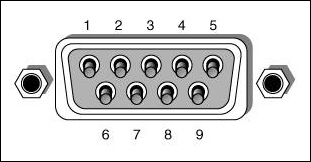
This image is my setup (where we used three adapters: two genders changers and one null modem):
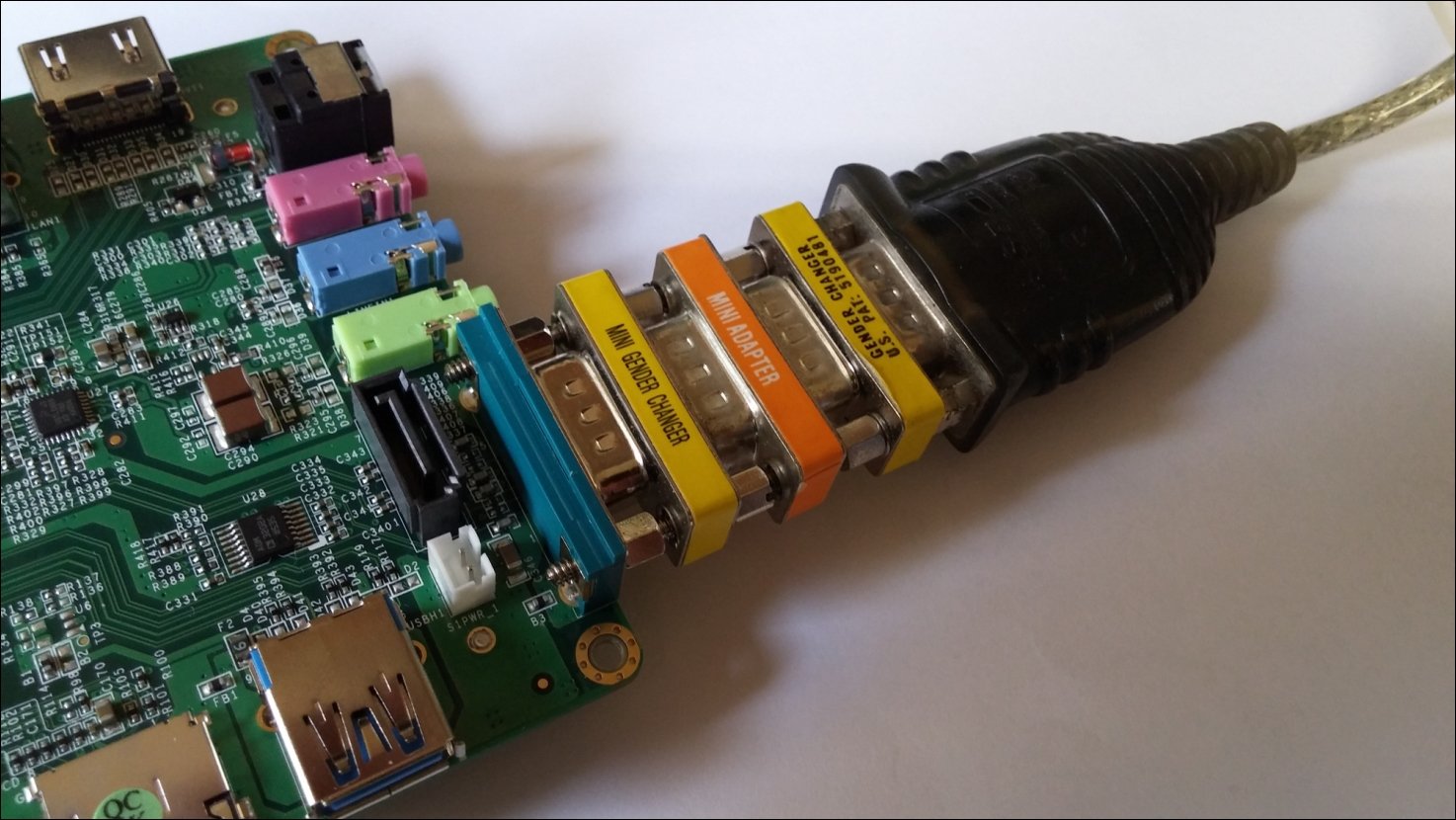
Now, let's install the software to start working with our WindBoard board.
To obtain the bootloader's sources, we can use the same trick used for the other boards, so we just need to clone a new one with the following command:
$ git clone --reference ~/Projects/common/u-boot.git
https://github.com/u-boot/u-boot
Now, let's go into the newly created directory and check out a proper U-boot release to use. Here are the commands used:
$ cd u-boot $ git checkout v2016.03 -b v2016.03
Here are the patches for the Wandboard:
$ wget -c https://rcn-ee.com/repos/git/u-boot-patches/v2016.03/0001-wa ndboard-uEnv.txt-bootz-n-fixes.patch $ patch -p1 < 0001-wandboard-uEnv.txt-bootz-n-fixes.patch
Now, we're ready to compile. Let's do it using the following commands:
$ make ARCH=arm CROSS_COMPILE=arm-linux-gnueabihf- wandboard_defconfig $ make ARCH=arm CROSS_COMPILE=arm-linux-gnueabihf-
Now, let's install the bootloader into the microSD.
Note
As done earlier, we have to discover the device associated with the microSD (see the BeagleBone Black or SAMA5D3 Xplained subsections). On my system, the device is still /dev/sdd.
In this case, we used a 16 GB microSD since we're going to install a lot of software on this board!
Now, we can clear the current partition table using the following command:
$ sudo dd if=/dev/zero of=/dev/sdX bs=1M count=10
Note
You must not forget to replace device /dev/sdX with the device associated with the microSD plugged into your system and follow the next steps carefully. Otherwise, it may damage the host system!
Then, we can install the newly compiled bootloaders:
$ sudo dd if=SPL of=/dev/sdX seek=1 bs=1k $ sudo dd if=u-boot.img of=/dev/sdX seek=69 bs=1k
Now, we can prepare the needed partition for the root filesystem, which will be installed in the upcoming sections. The commands are shown here:
$ echo '1M,,L,*' | sudo sfdisk /dev/sdX $ sudo mkfs.ext4 -L rootfs /dev/sdX1
Tip
As already stated for the other boards, we must notice that since the mkfs.ext4 version 1.43, the metadata_csum and 64bit options are enabled by default. However, we need to make sure that they are disabled. Otherwise, U-Boot cannot boot from our ext4 partitions. If this is our case, we need to replace the preceding command with the following one:
$ sudo mkfs.ext4 -L rootfs
-O ^metadata_csum,^64bit /dev/sdX1
Now, we can mount the newly created boot and rootfs partition as done earlier. Here are the commands:
$ sudo mkdir /media/rootfs $ sudo mount /dev/sdX1 /media/rootfs
Then, as done for the SAMA5D3 Xplained, we don't define an environment file uEnv.txt right now, but we will define it later since, in contrast to SAMA5D3 Xplained, we need it.
Now, it's time to compile the kernel.
The kernel sources are still the ones from Robert C. Nelson archives. The command is shown here:
$ git clone https://github.com/RobertCNelson/armv7-multiplatform
Then, we have to enter into the newly created directory and choose which version of the kernel we wish to use. Of course, we choose the same kernel release as the one mentioned earlier, and the commands are shown here:
$ cd armv7-multiplatform/ $ git checkout origin/v4.4.x -b v4.4.x
Now, we can redo the previous settings into the system.sh file, and then, we can start the compilation using the following command:
$ ./build_kernel.sh
Note
This step and the subsequent ones are time consuming and require patience, so you should take a cup of your preferred tea or coffee and just wait.
We should see that the correct cross-compiler is set and also see that the linux-stable repository is correctly referenced. Here is what I get on my system:
$ ./build_kernel.sh + Detected build host [Ubuntu 15.10] + host: [x86_64] + git HEAD commit: [44cd32b5f0ff74d2705541225c0d7cbdfb59bf50] ----------------------------- scripts/gcc: Using: arm-linux-gnueabihf-gcc (Linaro GCC 5.3-2016.02) 5 .3.1 20160113 Copyright (C) 2015 Free Software Foundation, Inc. This is free software; see the source for copying conditions. There i s NO warranty; not even for MERCHANTABILITY or FITNESS FOR A PARTICULA R PUR POSE. ----------------------------- CROSS_COMPILE=arm-linux-gnueabihf- ----------------------------- scripts/git: Debug: LINUX_GIT is setup as: [/home/giometti/Projects/co mmon/linux-stable]. scripts/git: [url=https://git.kernel.org/pub/scm/linux/kernel/git/stab le/linux-stable.git] From https://git.kernel.org/pub/scm/linux/kernel/git/stable/linux-stab le * branch HEAD -> FETCH_HEAD ----------------------------- Cloning into '/home/giometti/Projects/WB/armv7-multiplatform/KERNEL'.. . done. ...
After a while, the classic kernel configuration panel should appear. Just confirm the default settings by selecting the < Exit > menu option and continue.
When finished, we should see several messages as shown here:
... ----------------------------- 'arch/arm/boot/zImage' -> '/home/giometti/Projects/WB/armv7-multiplatf orm/deploy/4.4.7-armv7-x6.zImage' '.config' -> '/home/giometti/Projects/WB/armv7-multiplatform/deploy/co nfig-4.4.7-armv7-x6' -rwxrwxr-x 1 giometti giometti 5,6M apr 17 18:46 /home/giometti/Projec ts/WB/armv7-multiplatform/deploy/4.4.7-armv7-x6.zImage ----------------------------- Building modules archive... Compressing 4.4.7-armv7-x6-modules.tar.gz... -rw-rw-r-- 1 giometti giometti 89M apr 17 18:47 /home/giometti/Project s/WB/armv7-multiplatform/deploy/4.4.7-armv7-x6-modules.tar.gz ----------------------------- Building firmware archive... Compressing 4.4.7-armv7-x6-firmware.tar.gz... -rw-rw-r-- 1 giometti giometti 1,2M apr 17 18:47 /home/giometti/Projec ts/WB/armv7-multiplatform/deploy/4.4.7-armv7-x6-firmware.tar.gz ----------------------------- Building dtbs archive... Compressing 4.4.7-armv7-x6-dtbs.tar.gz... -rw-rw-r-- 1 giometti giometti 3,1M apr 17 18:47 /home/giometti/Projec ts/WB/armv7-multiplatform/deploy/4.4.7-armv7-x6-dtbs.tar.gz ----------------------------- Script Complete eewiki.net: [user@localhost:~$ export kernel_version=4.4.7-armv7-x6] -----------------------------
The last line tells us which is the kernel version to be defined in the uEnv.txt file defined earlier when we installed the bootloaders. The command is shown here:
$ sudo sh -c 'echo "uname_r=4.4.7-armv7-x6" >>
/media/rootfs/boot/uEnv.txt'
Now, we should install the kernel, but first, we need the root filesystem. So, let's move to the next subsection.
Like rootfs we can use the one already downloaded for the BeagleBone Black, so let's copy it into the microSD:
$ cd common/debian-8.4-minimal-armhf-2016-04-02/ $ sudo tar xpf armhf-rootfs-debian-jessie.tar -C /media/rootfs/
When finished, we can add the kernel image and the related files:
$ cd WB/armv7-multiplatform/ $ sudo cp deploy/4.4.7-armv7-x6.zImage /media/rootfs/boot/vmlinuz-4.4.7-armv7-x6 $ sudo mkdir -p /media/rootfs/boot/dtbs/4.4.7-armv7-x6/ $ sudo tar xf deploy/4.4.7-armv7-x6-dtbs.tar.gz -C /media/rootfs/boot/dtbs/4.4.7-armv7-x6/ $ sudo tar xf deploy/4.4.7-armv7-x6-modules.tar.gz -C /media/rootfs/
Now, to finish the job, we must set up the filesystem table using the following command:
$ sudo sh -c "echo '/dev/mmcblk0p1 / auto errors=remount-ro 0 1' > /media/rootfs/etc/fstab"
We also need to set up the networking configuration by executing the following commands:
$ sudo sh -c "echo 'allow-hotplug lo\niface lo inet loopback\n' > /media/rootfs/etc/network/interfaces" $ sudo sh -c "echo 'allow-hotplug eth0\niface eth0 inet dhcp' >> /media/rootfs/etc/network/interfaces"
Now, we should be ready to boot our new system! Let's unmount the microSD from the host PC, plug it into the Wandboard, and power on the board. The umount command line is shown here:
$ sudo umount /media/rootfs/
If everything works well on the serial console, we should see something like this:
U-Boot SPL 2016.03-dirty (Apr 21 2016 - 10:41:24) Trying to boot from MMC U-Boot 2016.03-dirty (Apr 21 2016 - 10:41:24 +0200) CPU: Freescale i.MX6Q rev1.5 at 792 MHz Reset cause: POR Board: Wandboard rev C1 I2C: ready DRAM: 2 GiB MMC: FSL_SDHC: 0, FSL_SDHC: 1 *** Warning - bad CRC, using default environment No panel detected: default to HDMI Display: HDMI (1024x768) In: serial Out: serial Err: serial Net: FEC [PRIME] Press SPACE to abort autoboot in 2 seconds switch to partitions #0, OK mmc0 is current device SD/MMC found on device 0 ... debug: [console=ttymxc0,115200 root=/dev/mmcblk0p1 ro rootfstype=ext4 rootwait] ... debug: [bootz 0x12000000 - 0x18000000] ... Kernel image @ 0x12000000 [ 0x000000 - 0x588ba0 ] ## Flattened Device Tree blob at 18000000 Booting using the fdt blob at 0x18000000 Using Device Tree in place at 18000000, end 1800f7f8 Starting kernel ... [ 0.000000] Booting Linux on physical CPU 0x0 ... [ 5.569385] random: systemd urandom read with 10 bits of entropy av ailable [ 5.582907] systemd[1]: systemd 215 running in system mode. (+PAM + AUDIT +SEL INUX +IMA +SYSVINIT +LIBCRYPTSETUP +GCRYPT +ACL +XZ -SECC OMP -APPARMOR ) [ 5.596522] systemd[1]: Detected architecture 'arm'. Welcome to Debian GNU/Linux 8 (jessie)! [ 5.637466] systemd[1]: Set hostname to <arm>. ... [ OK ] Started LSB: Apache2 web server. Debian GNU/Linux 8 arm ttymxc0 default username:password is [debian:temppwd] arm login:
Great! Everything is working now. We can log in by entering the root string as both username and password.
Before ending the chapter, let's review each board in order to verify that our newly created operating systems have whatever we need to proceed further in the book.
As soon as we log in to our new system, we see that the prompt looks like this:
root@arm:~#
Maybe, we can customize it a bit by changing the hostname from the generic string arm into a more appropriate bbb (which stands for BeagleBone Black). The commands to do the job are shown here:
root@arm:~# echo bbb > /etc/hostname root@arm:~# sed -i -e's/\<arm\>/bbb/g' /etc/hosts
Now, we have to reboot the system using the classic reboot command, and at the next login, we should get a welcome message:
Debian GNU/Linux 8 bbb ttyS0 default username:password is [debian:temppwd] bbb login:
After the login, we will get the new prompt:
root@bbb:~#
Then, we will update the distribution repositories and install the aptitude tool as done for the host machine:
root@bbb:~# apt-get update root@bbb:~# apt-get install aptitude
OK, now it is time to add a useful feature, that is, the possibility to establish a virtual Ethernet connection between our BeagleBone Black and the host PC over the USB cable connected with BeagleBone Black's USB device port and the host. To do this, we have first to install the udhcpd package using the following command:
root@bbb:~# aptitude install udhcpd
Then, we must add the following lines to the /etc/network/interfaces file:
allow-hotplug usb0
iface usb0 inet static
address 192.168.7.2
netmask 255.255.255.252
network 192.168.7.0
Then, restart the networking system as follows:
root@bbb:~# /etc/init.d/networking restart
IPv6: ADDRCONF(NETDEV_CHANGE): Black, we should see a message, as shown here, on the serial console:
g_ether gadget: high-speed config #1: CDC Ethernet (ECM) IPv6: ADDRCONF(NETDEV_CHANGE): usb0: link becomes ready
A new Ethernet device should appear as reported here:
root@bbb:~# ifconfig usb0 usb0 Link encap:Ethernet HWaddr 78:a5:04:ca:c9:f1 inet addr:192.168.7.2 Bcast:192.168.7.3 Mask:255.255.255.252 inet6 addr: fe80::7aa5:4ff:feca:c9f1/64 Scope:Link UP BROADCAST RUNNING MULTICAST MTU:1500 Metric:1 RX packets:46 errors:0 dropped:0 overruns:0 frame:0 TX packets:32 errors:0 dropped:0 overruns:0 carrier:0 collisions:0 txqueuelen:1000 RX bytes:7542 (7.3 KiB) TX bytes:5525 (5.3 KiB)
OK, now, we have to configure the new Ethernet device on the host and then we can try an ssh connection as shown here:
$ ssh root@192.168.7.2
Note
On my host PC, which is Ubuntu based, before executing the ssh command, we had to properly configure the new Ethernet device by adding a new network connection in the entry Edit Connections... in the system settings menu.
The authenticity of host '192.168.7.2 (192.168.7.2)' can't be establis hed. ECDSA key fingerprint is SHA256:Iu23gb49VFKsFs+HMwjza1OzcpzRL/zxFxjFpF EiDsg. Are you sure you want to continue connecting (yes/no)? yes Warning: Permanently added '192.168.7.2' (ECDSA) to the list of known hosts. root@192.168.7.2's password:
Now we have to enter the root's password that is root and the trick is done:
The programs included with the Debian GNU/Linux system are free softwa re; the exact distribution terms for each program are described in the individual files in /usr/share/doc/*/copyright. Debian GNU/Linux comes with ABSOLUTELY NO WARRANTY, to the extent permitted by applicable law. Last login: Sat Apr 2 18:28:44 2016 root@bbb:~#
Tip
We may need to modify the ssh daemon configuration if we cannot successfully log in to our system. In fact, the login by the root user may be disabled for security reasons. To enable the login, we have to modify the /etc/ssh/sshd_config file as follows:
--- /etc/ssh/sshd_config.orig 2016-04-02 18:40:31. 120000086 +0000 +++ /etc/ssh/sshd_config 2016-04-02 18:40:46.05000 0088 +0000 @@ -25,7 +25,7 @@ # Authentication: LoginGraceTime 120 -PermitRootLogin without-password +PermitRootLogin yes StrictModes yes RSAAuthentication yesThen, we have to restart the daemon using the following command:
root@bbb:~# /etc/init.d/ssh restart
Restarting ssh (via systemctl): ssh.service.
Now, we have to install the overlay system, that is, the mechanism that allow us to load at run time a part of a new device tree binaries and then change our kernel settings to get access to the board's peripherals (this mechanism will be used in the upcoming chapters, and it'll be more clear to you when we'll start using it).
To install the overlay mechanism, we must clone its repository into our BeagleBone Black as follows:
bbb@arm:~# git clone https://github.com/beagleboard/bb.org-overlays
Then, we must update the device tree compiler (the dtc command) with the following commands:
root@arm:~# cd bb.org-overlays/ root@arm:~/bb.org-overlays# ./dtc-overlay.sh
Installing: bison build-essential flex Get:1 http://repos.rcn-ee.com jessie InRelease [4,347 B] Get:2 http://repos.rcn-ee.com jessie/main armhf Packages [370 kB] ... Installing into: /usr/local/bin/ CHK version_gen.h INSTALL-BIN INSTALL-LIB INSTALL-INC dtc: Version: DTC 1.4.1-g1e75ebc9
Then, we can install the dtbo files with the following command:
root@arm:~/bb.org-overlays# ./install.sh CLEAN src/arm DTC src/arm/BB-BONE-WTHR-01-00B0.dtbo DTC src/arm/BB-BONE-LCD3-01-00A2.dtbo DTC src/arm/BB-PWM2-00A0.dtbo ... 'src/arm/univ-hdmi-00A0.dtbo' -> '/lib/firmware/univ-hdmi-00A0.dtbo' 'src/arm/univ-nhdmi-00A0.dtbo' -> '/lib/firmware/univ-nhdmi-00A0.dtbo' update-initramfs: Generating /boot/initrd.img-4.4.7-bone9 cape overlays have been built and added to /lib/firmware & /boot/initr d.img-4.4. 7-bone9, please reboot
OK, now, we can safely reboot the system to test it.
After reboot, to display the current overlay configuration, we can use the following cat command:
root@arm:~# cat /sys/devices/platform/bone_capemgr/slots 0: PF---- -1 1: PF---- -1 2: PF---- -1 3: PF---- -1
Then, we can try to enable the second SPI bus char device using the following command:
root@bbb:~# echo BB-SPIDEV1 > /sys/devices/platform/bone_capemgr/slots bone_capemgr bone_capemgr: part_number 'BB-SPIDEV1', version 'N/A' bone_capemgr bone_capemgr: slot #4: override bone_capemgr bone_capemgr: Using override eeprom data at slot 4 bone_capemgr bone_capemgr: slot #4: 'Override Board Name,00A0,Ove rride Manuf,BB-SPIDEV1' bone_capemgr bone_capemgr: slot #4: dtbo 'BB-SPIDEV1-00A0.dtbo' loaded; overlay id#0
Now, two new char devices should appear in the /dev directory:
root@bbb:~# ls -l /dev/spidev* crw-rw---- 1 root spi 153, 0 Apr 2 19:27 /dev/spidev2.0 crw-rw---- 1 root spi 153, 1 Apr 2 19:27 /dev/spidev2.1
Also, the slots file in sysfs is updated accordingly:
root@bbb:~# cat /sys/devices/platform/bone_capemgr/slots 0: PF---- -1 1: PF---- -1 2: PF---- -1 3: PF---- -1 4: P-O-L- 0 Override Board Name,00A0,Override Manuf,BB-SPIDEV1
Now, everything should be in place. However, as the last step, we can decide to copy our new system from the microSD card to eMMC in order to boot directly from the on-board eMMC device, thus avoiding pressing the user button each time we power up the board.
To do this, we have to install three new packages (initramfs-tools, dosfstools, and rsync) and then use a script form the Robert C. Nelson archive:
root@bbb:~# wget https://raw.githubusercontent.com/RobertCNelson/boot-
scripts/master/tools/eMMC/bbb-eMMC-flasher-eewiki-ext4.sh
Then, we just need to execute it using the following two commands, and the BeagleBone Black will start rewriting the eMMC contents:
root@bbb:~# chmod +x bbb-eMMC-flasher-eewiki-ext4.sh root@bbb:~# /bin/bash ./bbb-eMMC-flasher-eewiki-ext4.sh
Even for the SAMA5D3 Xplained, we can have a pretty prompt. So, let's change it as done for the BeagleBone Black:
root@arm:~# echo a5d3 > /etc/hostname root@arm:~# sed -i -e's/\<arm\>/a5d3/g' /etc/hosts
Now, we can reboot, and we should get a new welcome message as shown here:
Debian GNU/Linux 8 a5d3 ttyS0 default username:password is [debian:temppwd] a5d3 login:
Then, we will update the distribution repositories and install the aptitude tool as done for the host machine:
root@a5d3:~# apt-get update root@a5d3:~# apt-get install aptitude
OK, now, we can try to replicate BeagleBone Black's configuration, allowing an ssh connection via the USB device port. However, this time, we'll do more. In fact, we will install two kinds of different virtual connections over the USB cable: an Ethernet and a serial connection.
To do this, we need the USB gadget driver named CDC Composite Device (Ethernet and ACM) (see the kernel configuration settings done earlier for the SAMA5D3 Xplained):
root@a5d3:~# modprobe g_cdc host_addr=78:A5:04:CA:CB:01
The kernel messages we should see on the serial console are reported here, and they show that we have two new devices now:
using random self ethernet address using random host ethernet address using host ethernet address: 78:A5:04:CA:CB:01 usb0: HOST MAC 78:a5:04:ca:cb:01 usb0: MAC 22:6c:23:f0:10:62 g_cdc gadget: CDC Composite Gadget, version: King Kamehameha Day 2008 g_cdc gadget: g_cdc ready g_cdc gadget: high-speed config #1: CDC Composite (ECM + ACM)
In fact, now. we should have a new Ethernet device named usb0:
root@a5d3:~# ifconfig usb0 usb0 Link encap:Ethernet HWaddr da:a0:89:f9:a6:1d BROADCAST MULTICAST MTU:1500 Metric:1 RX packets:0 errors:0 dropped:0 overruns:0 frame:0 TX packets:0 errors:0 dropped:0 overruns:0 carrier:0 collisions:0 txqueuelen:1000 RX bytes:0 (0.0 B) TX bytes:0 (0.0 B)
And , we should have a new serial port:
root@a5d3:~# ls -l /dev/ttyGS0 crw-rw---- 1 root dialout 250, 0 Apr 2 18:28 /dev/ttyGS0
To force this new setting at every boot, we can add the kernel module name to the auto-loading module system:
root@a5d3:~# echo "g_cdc" >> /etc/modules-load.d/modules.conf root@a5d3:~# echo "options g_cdc host_addr=78:A5:04:CA:CB:01" >> /etc/modprobe.d/modules.conf
Note
The host_addr parameter is needed to allow the host PC to recognize our device and then correctly configure it by forcing a well-known MAC address each time we start the board.
Then, we can reboot the board, and the kernel module should be already present:
root@a5d3:~# lsmod Module Size Used by usb_f_acm 3680 1 u_serial 6214 3 usb_f_acm usb_f_ecm 4430 1 g_cdc 2165 0 u_ether 6869 2 g_cdc,usb_f_ecm libcomposite 26527 3 g_cdc,usb_f_acm,usb_f_ecm
Good! Now, we can start configuring them.
Regarding the Ethernet device, we can repeat what we did for the BeagleBone Black by adding the following lines to the /etc/network/interfaces file:
allow-hotplug usb0
iface usb0 inet static
address 192.168.8.2
netmask 255.255.255.252
network 192.168.8.0
Tip
In order to avoid conflicts with the BeagleBone Black setting, we used the 192.168.8.X subnetwork for this board instead of 192.168.7.X used for the BeagleBone Black.
Then, we've to restart the networking system as follows:
root@a5d3:~# /etc/init.d/networking restart
Tip
As we did earlier, we may need to enable the root login via ssh by modifying the PermitRootLogin setting in the /etc/ssh/sshd_config file and then restarting the daemon.
Then, we have to install the udhcpd daemon as we did earlier and then replace its current configuration in the /etc/udhcpd.conf file with the following settings:
start 192.168.8.1 end 192.168.8.1 interface usb0 max_leases 1 option subnet 255.255.255.252
Tip
We can save the daemon's old configuration with the following command:
root@a5d3:~# mv /etc/udhcpd.conf
/etc/udhcpd.conf.orig
Then, we must enable it by setting the DHCPD_ENABLED variable to yes in the /etc/default/udhcpd file. Then, restart the daemon:
root@a5d3:~# /etc/init.d/udhcpd restart
Now, regarding the serial connection, we can add the ability to do a serial login by adding a new getty service on it with the following commands:
root@a5d3:~# systemctl enable getty@ttyGS0.service Created symlink from /etc/systemd/system/getty.target.wants/getty@ttyG S0.service to /lib/systemd/system/getty@.service. root@a5d3:~# systemctl start getty@ttyGS0.service
Now, we only need to add the following lines to the /etc/securetty file in order to allow the root user to login using this new communication channel:
# USB gadget ttyGS0
OK, now, if we take a look at the host PC's kernel messages, we should see something as like this:
usb 1-1: new high-speed USB device number 3 using ehci-pci usb 1-1: New USB device found, idVendor=0525, idProduct=a4aa usb 1-1: New USB device strings: Mfr=1, Product=2, SerialNumber=0 usb 1-1: Product: CDC Composite Gadget usb 1-1: Manufacturer: Linux 4.4.6-sama5-armv7-r5 with atmel_usba_udc cdc_ether 1-1:1.0 eth0: register 'cdc_ether' at usb-0000:00:0b.0-1, CDC Ethernet Device, 78:a5:04:ca:cb:01 cdc_acm 1-1:1.2: ttyACM0: USB ACM device
Then, we can test the networking connection with the ssh command with the following command line on the host PC:
$ ssh root@192.168.8.2 The authenticity of host '192.168.8.2 (192.168.8.2)' can't be establis hed. ECDSA key fingerprint is SHA256:OduXLAPIYgNR7Xxh8XbhSum+zOKHBbgv/tnbeD j2O30. Are you sure you want to continue connecting (yes/no)? yes Warning: Permanently added '192.168.8.2' (ECDSA) to the list of known hosts. root@192.168.8.2's password:
Now, enter the root's password that is the root string and the job is done:
The programs included with the Debian GNU/Linux system are free software; the exact distribution terms for each program are described in the individual files in /usr/share/doc/*/copyright. Debian GNU/Linux comes with ABSOLUTELY NO WARRANTY, to the extent permitted by applicable law. Last login: Sat Apr 2 18:02:23 2016 root@a5d3:~#
Then, the serial connection can be tested using the minicom command as shown here:
$ sudo minicom -o -D /dev/ttyACM0 Debian GNU/Linux 8 a5d3 ttyGS0 default username:password is [debian:temppwd] a5d3 login:
Now, our SAMA5D3 Xplained is ready, and we can step next to the Wandboard.
Again, we like to have a pretty prompt. So, let's change it as we did for the BeagleBone Black:
root@arm:~# echo wb > /etc/hostname root@arm:~# sed -i -e's/\<wb\>/a5d3/g' /etc/hosts
Now, we can reboot the system, and we should get a new welcome message as shown here:
Debian GNU/Linux 8 wb ttymxc0 default username:password is [debian:temppwd] wb login:
Then, we will update the distribution repositories and install the aptitude tool as done for the host machine:
root@wb:~# apt-get update root@wb:~# apt-get install aptitude
OK, now, we can try to replicate BeagleBone Black's configuration by allowing an ssh connection via the USB device port. So, let's install the udhcpd package using the usual aptitude command:
root@wb:~# aptitude install udhcpd
Then, add the following lines to the /etc/network/interfaces file:
allow-hotplug usb0
iface usb0 inet static
address 192.168.9.2
netmask 255.255.255.252
network 192.168.9.0
Note
In order to avoid conflicts with the BeagleBone Black and SAMA5D3 Xplained settings, we used the subnetwork 192.168.9.X for this board instead of 192.168.7.X used for the BeagleBone Black or the 192.168.8.X used for the SAMA5D3 Xplained.
Then, restart the networking system as follows:
root@wb:~# /etc/init.d/networking restart
Note
As we did earlier, we may need to enable the root login via ssh by modifying the PermitRootLogin setting in the /etc/ssh/sshd_config file and then restarting the daemon.
Then, we have to install the udhcpd daemon as we did earlier and then replace its current configuration in /etc/udhcpd.conf file with the following settings:
start 192.168.9.1 end 192.168.9.1 interface usb0 max_leases 1 option subnet 255.255.255.252
Tip
We can save the daemon's old configuration with the following command:
root@wb:~# mv /etc/udhcpd.conf /etc/udhcpd.conf.orig
Then, we must enable it by setting the DHCPD_ENABLED variable to yes in the /etc/default/udhcpd file. Then, restart the daemon:
root@wb:~# /etc/init.d/udhcpd restart
Now, if we try to connect to the host PC with our Wandboard, we should see the following message on the serial console:
g_ether gadget: high-speed config #1: CDC Ethernet (ECM) IPv6: ADDRCONF(NETDEV_CHANGE): usb0: link becomes ready
A new Ethernet device should appear as reported here:
root@wb:~# ifconfig usb0 usb0 Link encap:Ethernet HWaddr 62:1e:f6:88:9b:42 inet addr:192.168.9.2 Bcast:192.168.9.3 Mask:255.255.255.252 inet6 addr: fe80::601e:f6ff:fe88:9b42/64 Scope:Link UP BROADCAST RUNNING MULTICAST MTU:1500 Metric:1 RX packets:0 errors:0 dropped:0 overruns:0 frame:0 TX packets:30 errors:0 dropped:0 overruns:0 carrier:0 collisions:0 txqueuelen:1000 RX bytes:0 (0.0 B) TX bytes:5912 (5.7 KiB)
OK, now, we have to configure the new Ethernet device on the host, and then, we can try an ssh connection as shown here:
$ ssh root@192.168.9.2
Tip
On my host PC that is Ubuntu based, before executing the ssh command earlier, we had to properly configure the new Ethernet device by adding a new network connection in the entry Edit Connections... in the system settings menu.
The authenticity of host '192.168.9.2 (192.168.9.2)' can't be establis hed. ECDSA key fingerprint is SHA256:Xp2Bf+YOWL0kDSm00GxXw9CY5wH+ECnPzp0EHp 3+GM8. Are you sure you want to continue connecting (yes/no)? yes Warning: Permanently added '192.168.9.2' (ECDSA) to the list of known hosts. root@192.168.9.2's password:
Now, enter the root's password that is the root string and the job is done:
The programs included with the Debian GNU/Linux system are free softwa re; the exact distribution terms for each program are described in the individual files in /usr/share/doc/*/copyright. Debian GNU/Linux comes with ABSOLUTELY NO WARRANTY, to the extent permitted by applicable law. Last login: Sat Apr 2 17:45:31 2016 root@wb:~#
Ok now, as last step, we have to set up the on-board Wi-Fi chip. To do this, we need to download the firmware. Here are the commands:
root@wb:~# mkdir -p /lib/firmware/brcm/ root@wb:~# cd /lib/firmware/brcm/ root@wb:/lib/firmware/brcm# wget -c https://git.kernel.org/cgit/linux/kernel/git/firmware/linux-fi rmware.git/plain/brcm/brcmfmac4329-sdio.bin root@wb:/lib/firmware/brcm# wget -c https://git.kernel.org/cgit/linux/kernel/git/firmware/linux-fi rmware.git/plain/brcm/brcmfmac4330-sdio.bin root@wb:/lib/firmware/brcm# wget -c https://rcn-ee.com/repos/git/meta-fsl-arm-extra/recipes-bsp/br oadcom-nvram-config/files/wandboard/brcmfmac4329-sdio.txt root@wb:/lib/firmware/brcm# wget -c https://rcn-ee.com/repos/git/meta-fsl-arm-extra/recipes-bsp/br oadcom-nvram-config/files/wandboard/brcmfmac4330-sdio.txt
Then, we have to reboot the system with the usual reboot command. After reboot, if everything works well, we should see a new interface named wlan0 as shown here:
root@wb:~# ifconfig wlan0 wlan0 Link encap:Ethernet HWaddr 44:39:c4:9a:96:24 BROADCAST MULTICAST MTU:1500 Metric:1 RX packets:0 errors:0 dropped:0 overruns:0 frame:0 TX packets:0 errors:0 dropped:0 overruns:0 carrier:0 collisions:0 txqueuelen:1000 RX bytes:0 (0.0 B) TX bytes:0 (0.0 B)
Now, we have to verify that it works. So, as the first step, let's try a wireless network scan:
root@wb:~# ifconfig wlan0 0.0.0.0 root@wb:~# iwlist wlan0 scan | grep ESSID ESSID:"EnneEnne"
Great, my home network has been recognized!
Note
We may need to connect the external antenna in order to correctly detect all wireless networks around. The external antenna connector is labeled as ANT near the Wi-Fi chip.
For the moment, we can stop the Wi-Fi setup here since it will be restarted later in this book in a proper chapter.
Before ending this chapter, let me suggest that you install some basic and common tools we're going to use in this book. We can decide to install these tools now or, when needed, later during the reading of the book.
If we decide to perform this last step and then install these tools right now, we have to connect our boards to the Internet using, for example, an Ethernet cable, and then setting a suitable network configuration for it.
Let me remember that if our embedded kit doesn't automatically take a network configuration and we have a DHCP server in our LAN, we can force this behavior using the dhclient command:
# dhclient eth0
If we don't have a running DHCP service, we can manually set up a network configuration using the ifconfig and route commands as shown here:
# ifconfig eth0 <LOCAL-IP-ADDR> # route add default gw <GATEWAY-IP-ADDR>
OK, now, to install our tools, we can use the aptitude command again and then wait for the complete installation:
# aptitude install autoconf git subversion make gcc libtool pkg-config bison build-essential flex strace php5-cli python-pip libpython-dev
In this chapter, we took a first look at our new embedded developer kits. You learned how to reinstall a fresh Debian OS from scratch on all systems and how to get access to their serial consoles.
In the next chapter, we will continue to experience the serial console in order to well understand how we can use it in every contest, from the early booting stages inside the bootloader to the normal system setup and management.




















 Download code from GitHub
Download code from GitHub





